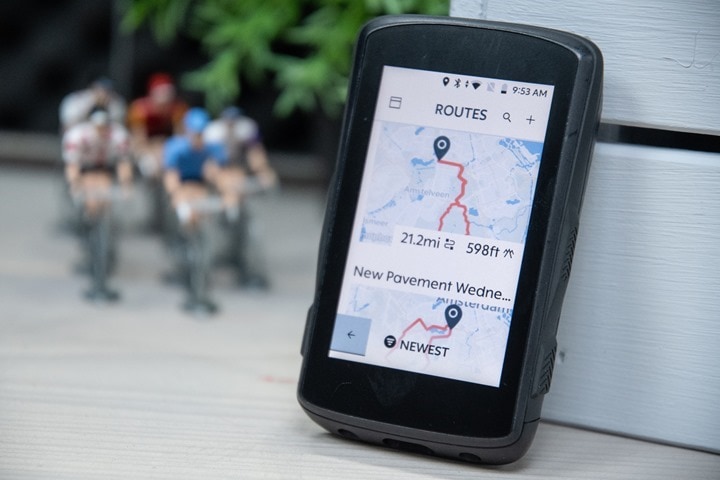
In most ways, the Hammerhead Karoo 2 is probably the most eagerly anticipated bike computer release of 2020. And not just because I feel like we've been waiting and talking about this moment for nearly the entire year, but because I think that they, alongside Wahoo, represent the most viable competitors to a higher-end Garmin Edge device. But for many people, myself included, it's simply that high-resolution brilliant display that draws us in – like mosquitos to a hot summer evening bright light fly zapper.
The question is – how close does Hammerhead get with the Karoo 2 to being a true Garmin alternative? And what's changed from the original Karoo 1? And perhaps most importantly – when the heck do these start shipping?
Well, they're shipping already. For those that pre-ordered this past summer, those orders are sliding out in batches, one of the biggest being just yesterday, and will continue over the next few weeks. More on the nuanced details for everyone else without pre-orders, a bit later in the post.
Second – what's new? Well, a beeper. It makes noise now. So when you get that navigational turn alert, you'll actually hear it chirp – versus before it was as noisy as a mime. It's also got significantly upgraded internals that will eventually be tapped for more advanced features. Plus, it can now integrate with your phone for smartphone notifications. But beyond that – they've taken an Apple-like approach of all new features having already been dropped onto the existing Karoo 1. As long as the hardware is capable, Hammerhead is going to keep updates coming.
With that out of the way, note that Hammerhead sent over a media loaner that I've been using for the last month or so. Well, two units actually. More on that later. Once I'm done with it I'll pack it back up and go out and pick up my own through normal retail channels. Just the way I roll. If you found this review useful you can become a DCR Supporter to help support the site, details on that at the bottom! With that, let's get into it.
Quick Specs & Newness:
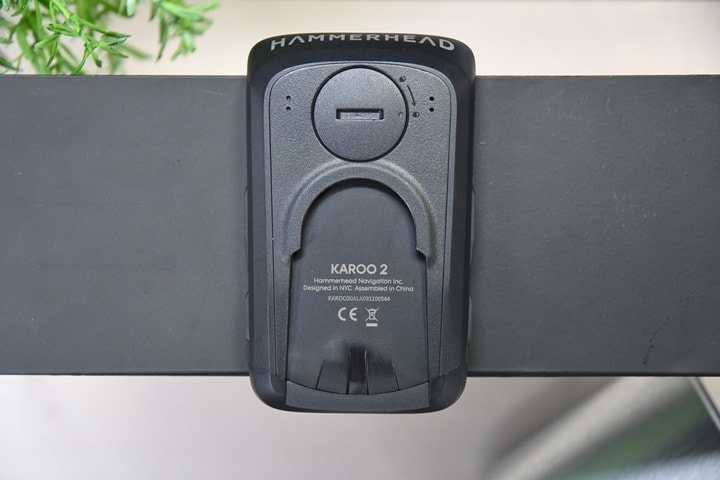
The main changes to the Karoo 2 are largely hardware driven. The most obvious being size. It's no longer the XL Bacon Cheeseburger that was the original Karoo 1, instead, the size here is much more akin to a Wahoo ROAM or slightly smaller than a Garmin Edge 1030 in size. It's a touch bigger than the Garmin Edge 530/830, but not so much that it feels big. This new hardware retains one of the signature elements of the original Karoo – a cellular SIM card slot. But beyond those visually visible things, almost all the other changes are inside under the covers from a processing standpoint. They've upgraded memory, processor, and Bluetooth chipsets – making it faster and more capable for future updates.
They've also upgraded the version of Android it runs, from Android 6.0 to Android 8.0. As part of all these changes, the unit can now pair to your phone for smartphone notifications. It still can't offload rides or sync details via Bluetooth (yet – that's coming in 2021 to both iOS and Android), instead relying on WiFi as before (or, cellular if you have a SIM card inside it). Still, I used it without issue to receive notifications throughout the ride from my phone, and those notifications felt far more robustly phone-like than constrained one or two line text tidbits as seen on a Garmin or Wahoo device.
Like just about any bike computer GPS it's got all the basics you'd expect:
– Records your ride using GPS – up to 12hrs battery life
– Full color touchscreen display, glove and rain friendly (mostly)
– Connects to ANT+ & Bluetooth Smart sensors (full list later in review)
– Pulls routes from Strava, RideWithGPS, Komoot, and others
– Pushes completed rides to TrainingPeaks, Strava, and others
– Gives turn by turn directions with full color/detailed maps for anywhere in the world
– Can re-route on the fly if you go off-course
– Can do structured workouts from TrainingPeaks, including smart trainer control
But what's important is what's changed. So here's the differences hardware-wise compared to Karoo 1:
– Added a beeper (you can still pair Bluetooth headphones/speakers)
– Reduced size dimensions (in mm, now 60.8w x 19.3h x 100.6L vs 73w x 28h x 99L)
– Reduced unit weight from 186g to 132g
– Reduced mount weight from 55g to 33g
– Storage in the Karoo 2 is 32GB instead of 16GB
– Screen is covered in DragonTrail glass, which is sorta like Gorilla Glass – treated to reduce glare
– USB-C port waterproof spec IP67
– Added 4G coverage (2G/3G/4G, with your own SIM)
– Added dual Bluetooth Smart chipsets
– Added quad-core processor
And here's what's unique on the Karoo 2 software-wise that isn't on Karoo 1:
– Smartphone notifications which are customizable by category
– Setup tool via website to pre-configure Karoo so that when it arrives in mail, you just connect to WiFi and it's ready to go
– Various changes to sensor management
– Various changes to in-ride screens to handle different size
Ok, with that – let's get this thing unboxed.
Unboxing:
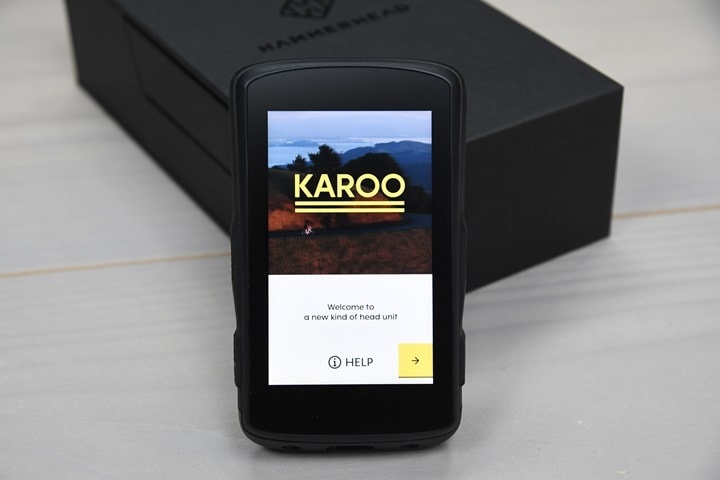
While the Karoo 2 unboxing is kinda like one of those crazy paper pop-up cards, it's what happens after you turn on the unit for the first time that's on-point. They've completely nailed that first 15-second experience with a dramatic cycling scene video that plays on loop, welcoming you to the Karoo 2. It sounds trivial, but it basically says 'Welcome to the future of what a cycling screen should look like'. And of course, obviously…with a drone shot. Because drone shots make all cycling videos better.
But before we get there, we need to extract the unit and parts from the box.

The matte black box accented with a glossy Hammerhead logo slides open from the side, revealing a tiered set of components.
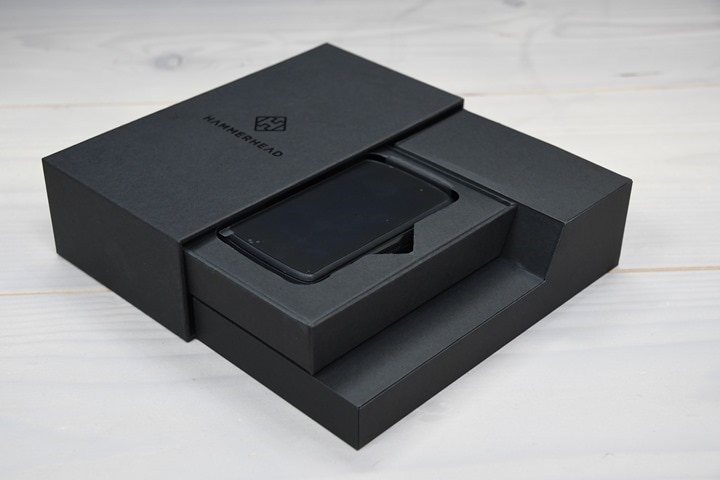
In the top section you'll find the Karoo 2 itself, as well as a little mini-instruction pamphlet to tell you how to power it on, notable because the buttons have no labels.
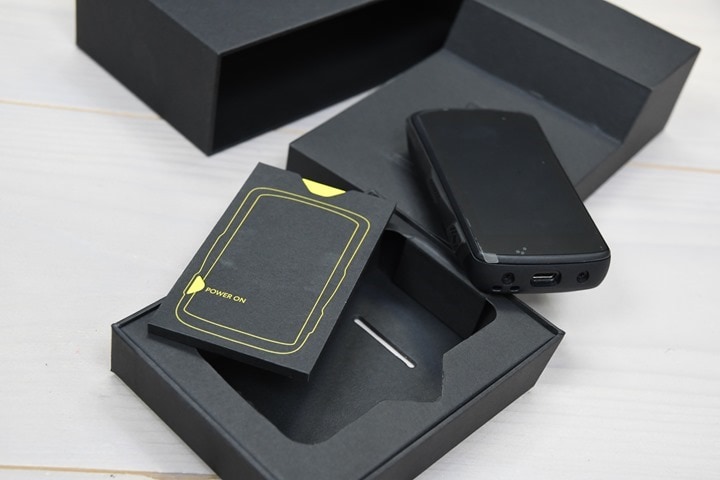
Below deck is the new Karoo 2 out-front mount, as well as a Garmin to Karoo quarter-turn mount adapter, letting you use your Karoo 2 with the gazillion 3rd party Garmin quarter-turn mounts found the world around, notably also found built-into some bikes/handlebars these days. As of current, they're only planning on including that adapter for pre-order customers.
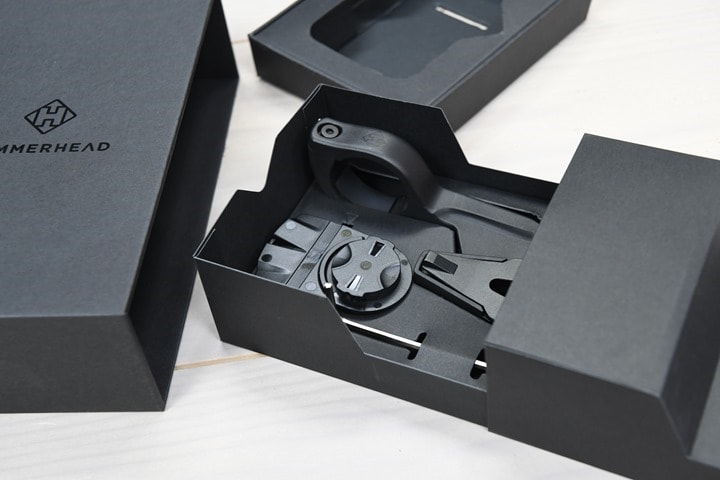
On the backside of this crazy unboxing situation is another box that includes a braided nylon USB-C cable, and a lanyard.
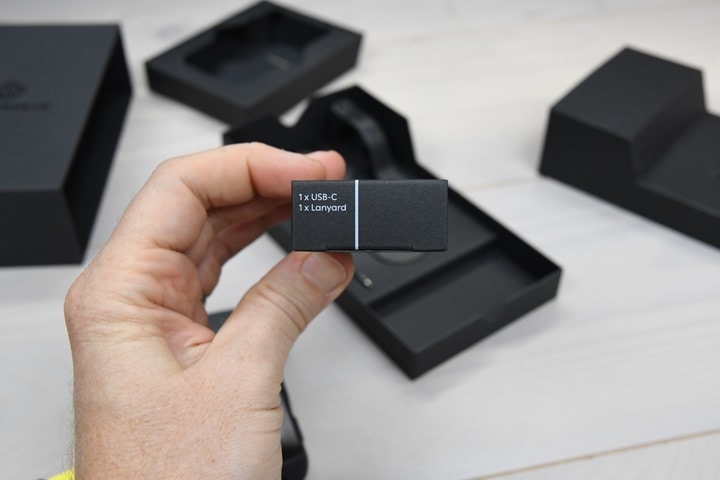
Once you compose yourself from all unboxing all the levels, here's what's left:
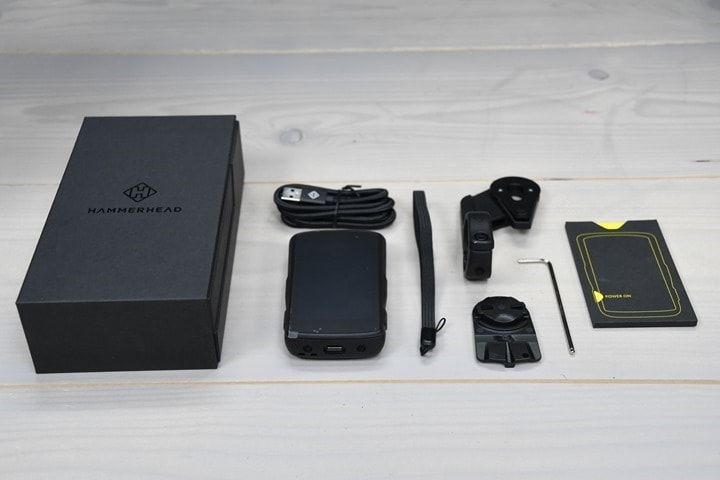
And, a close-up gallery of all those same components:
Next, for a quick size comparison, here's a lineup of like-minded units in the mid to upper end of the cycling GPS landscape.
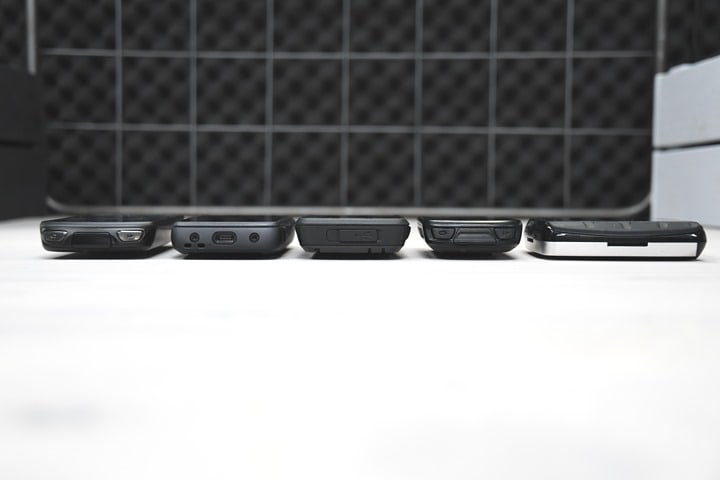
Left to right: Edge 1030 Plus, Hammerhead Karoo 2, Wahoo ROAM, Edge 530/830, Stages Dash L50
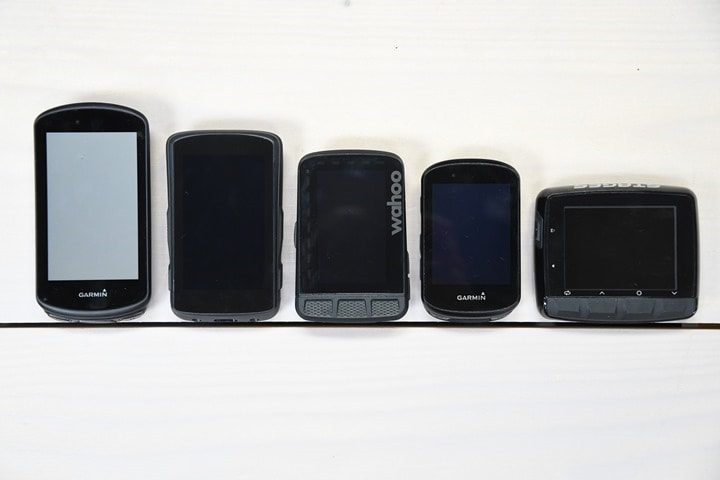
And here it is compared to the Karoo 1:
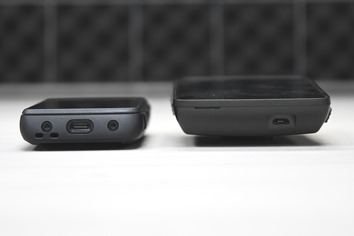

And then, here's a look at the weights of them. While the Karoo 2 has lost a lot of weight – and bulk, compared to the original Karoo 1, it's still a heavyweight of a unit in comparison to other products on the market. After all, the bigger screened Edge 1030/1030 Plus is still barely lighter than it. Realistically speaking you won't notice, but I did find it interesting while weighing them all in.
Ok, with that let's get it started and setup.
Initial Setup:
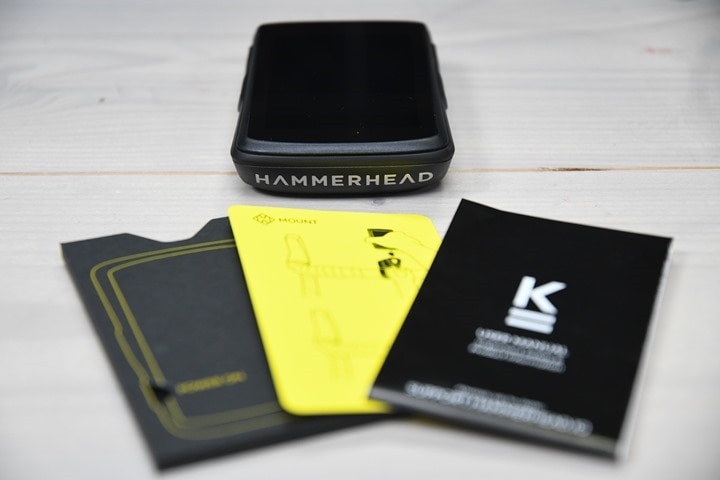
The Karoo 2 is designed to be more like a phone than a bike computer, in terms of the initial setup experience. Once you've gotten past that aforementioned drone cycling video on loop, you'll be asked to connect to WiFi. That's because there is no Karoo companion app, at least in the traditional sense. On Android there is an app, but it merely handles smartphone notifications – not syncing of data or configuration. Instead, all of that is done via WiFi (or, a SIM card if you so choose).
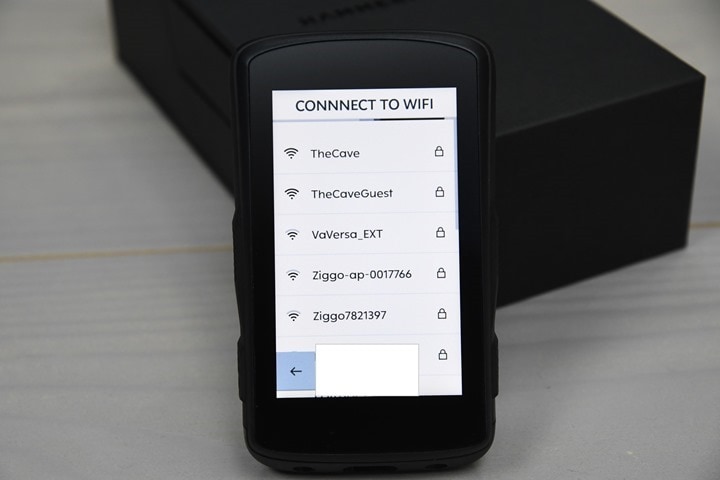
You'll simply enter in your WiFi details like normal:
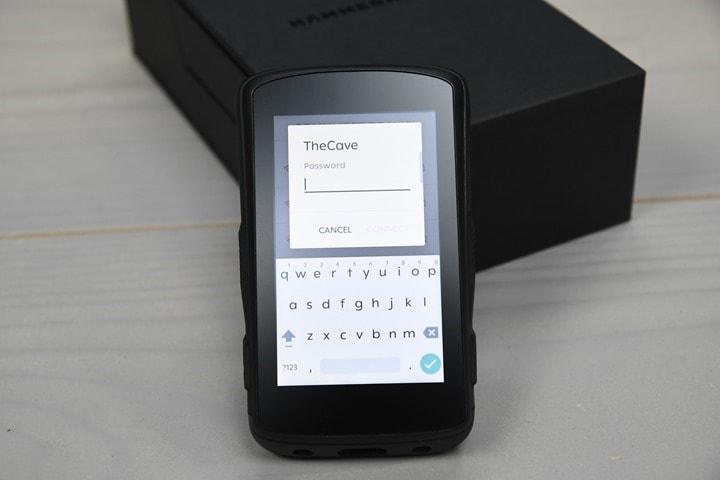
Before it goes any further, it grabs the latest software update from Hammerhead:

And after it's done doing that (it usually takes 2-3 minutes), it finally asks you for your username and password. This is because it's pulling in all your settings from their cloud platform. Or at least most of them. This includes your data pages/fields, Strava/TrainingPeaks/Komoot details, as well as general profile information like gender and age.
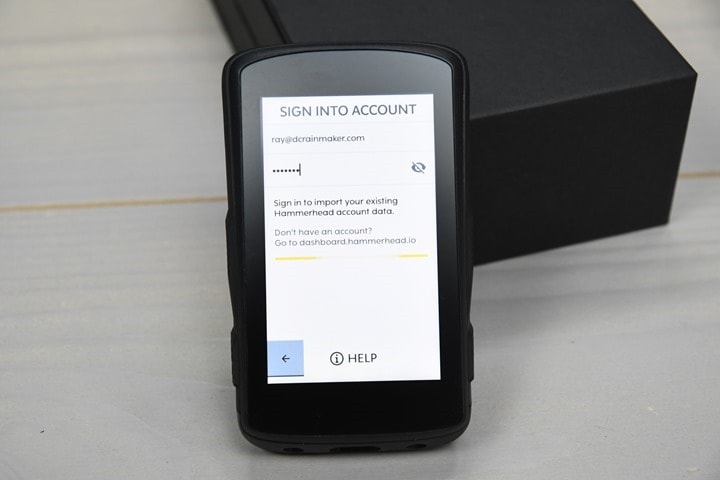
However, there are some settings it doesn't pull in – such as sensors.
In terms of how this compares to Garmin or Wahoo, it's similar, but different. For example, Garmin's latest Edge 130 Plus and 1030 Plus units now do pull in all your past data pages/fields from older Garmin Edge devices, as well as pull in your sensors.
Wahoo doesn't pull in data pages or sensors from other Wahoo units, but does make it easier to configure those data pages on your phone. All three companies use backend platforms to handle your Strava/TrainingPeaks/Komoot integrations, so that's the same here too – that's all pre-done for you.
Both Garmin and Wahoo select to download the update after the initial setup, rather than before it like Hammerhead. Whereas, both Wahoo and Karoo will grab your exact regions map after initial setup too. Garmin has the maps pre-loaded for the region you bought it in, and extra maps can be downloaded later (depending on which unit you get). Again, this area is mostly a wash.
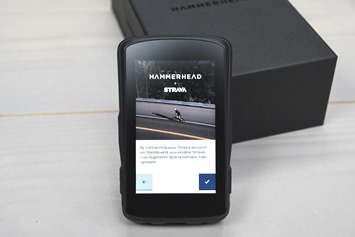
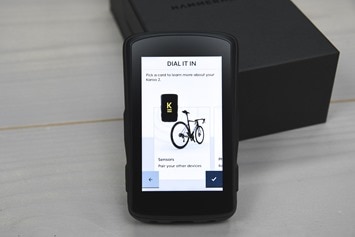
After a few quick informational pages on setting up Strava and sensors, you're basically ready to roll. However, do ensure you wait for everything to sync – especially your map region. By default the unit will automatically have started grabbing your correct map details, even without GPS. Meaning, even in the DCR Cave (which is under a 6 story building without GPS), it automatically started pulling in the Netherlands maps because that information is in my user profile. All in, just give your unit about 5-10 minutes for it to finish doing what it needs to do before bolting out the door.
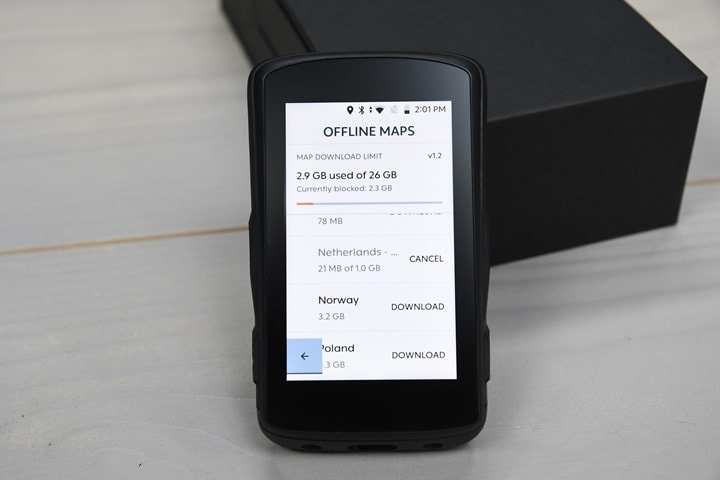
Once that's done, you'll find your existing profiles already configured, or, ready to start using them.
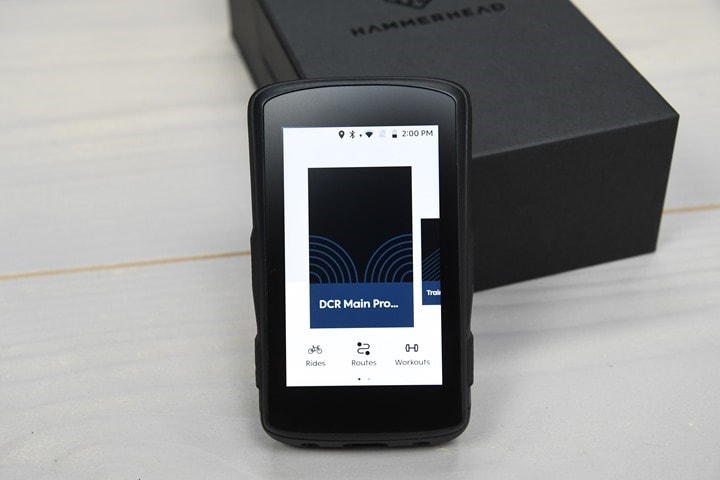
Note that if you haven't linked any 3rd party accounts, you can do that via the Hammerhead portal online, which is also where you can manage rides, and look at finished ride details.

I would argue that I'd really like to see Hammerhead set a goal of increasing these partnership accounts by 3x by the end of 2021. Compared to their competitors, this is a rather small number of partnerships to send your data files to. For example, missing are platforms like Relive, SportTracks, MapMyFitness, Today's Plan, Final Surge, TrainerRoad, Xert, and countless other smaller ones. Or heck, I'd also love to see Dropbox added – it's one of my favorite Wahoo ELEMNT series features.
Ok, with everything all setup, let's roll into day to day aspects.
The Basics:
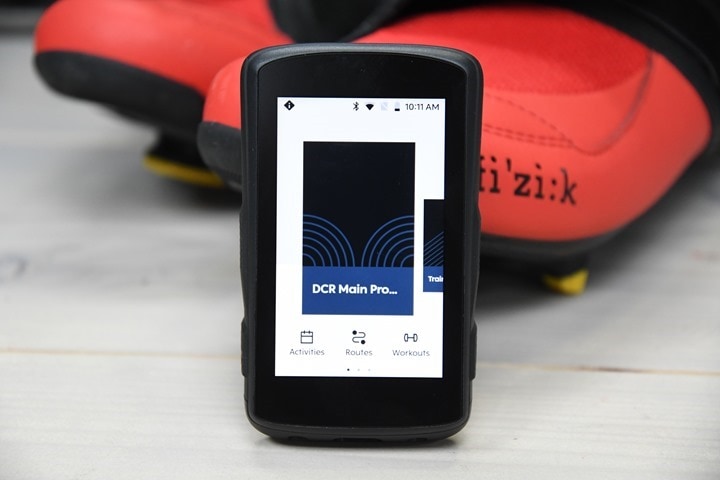
The Karoo 2 powers on by holding the lower left button. It's definitely not the fastest unit to startup for the first time, roughly akin to starting any modern smartphone (because…under the covers, that's what it is). On the upper portion of the screen you'll see your profiles, which you can create/customize as you see fit. Meanwhile, along the bottom of the dashboard are the core areas of the Karoo 2:
– Rides: Your past activities
– Routes: Your routes from platforms like Strava or Komoot, plus ones you've created
– Workouts: Structured workouts from TrainingPeaks
– Profiles: This is where you tweak data pages and fields
– Sensors: Pairing of sensors (including trainers and Varia radar)
– Settings: Twisty knobs for all the things
In addition, you can swipe down from the top to get quick access to a few things, like WiFi, cellular, auto-pause, sensors, audio alerts, and battery states. Some of these require long-holds, such as Sensors, in order to access further details (versus just toggling on/off).

First up along the bottom is 'Rides'. This is where you can see all your past rides. While you can change the title of the rides manually, I rarely remember to. Thus, everything for me is simply listed by the time.
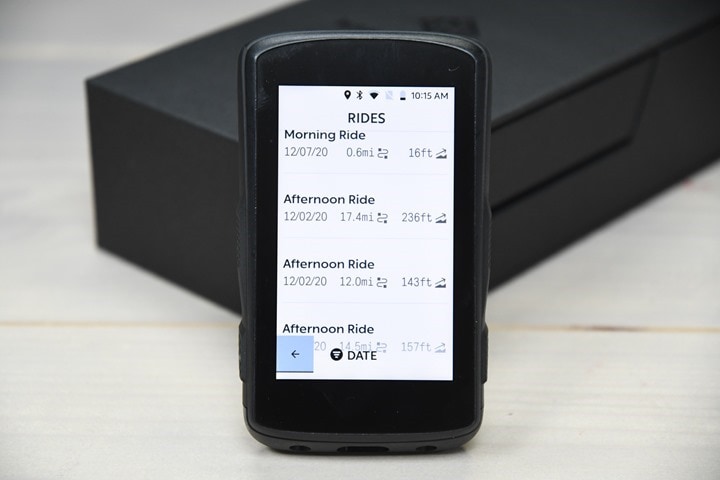
Above is a great example of where the UI could mature a bit more. For example, they could mirror how it shows the mini-map in the Routes section (which I'll show in a second). Sure, other companies just show a line item, but other companies don't have Hammerhead's display. Hammerhead: Use it!
Once you tap on a ride you can see some top-line stats, but again, it's super slim here. Unlike every other company, you can't see a quick preview of where the ride was map-wise, and even structured workout rides don't show a quick chart of the workout. Again, so much potential here.
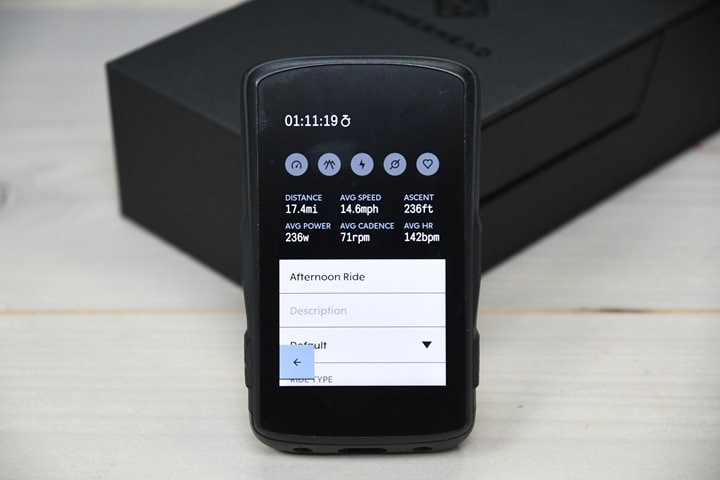
Going back to the dashboard there's the routes page, this is where you select a new route to ride, and a great example of how the completed rides screen should look IMHO.
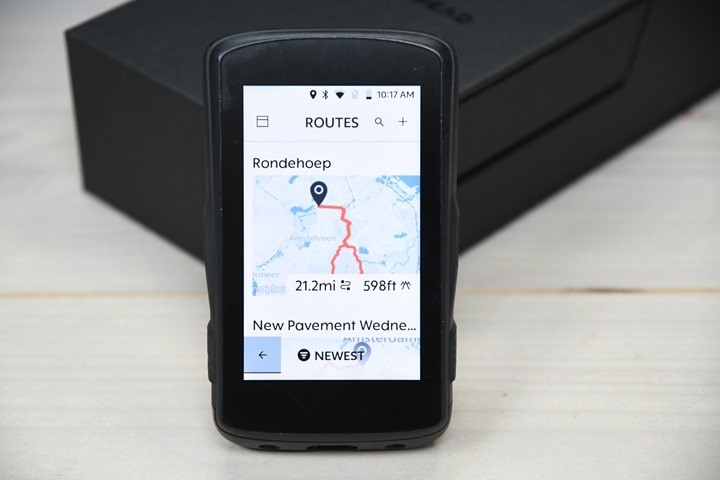
Now I'm going to dive into routes in the Navigation section in far more detail, so we'll move onto the next chunk, which is workouts. This is where you select workouts from TrainingPeaks that are synced from your account there.
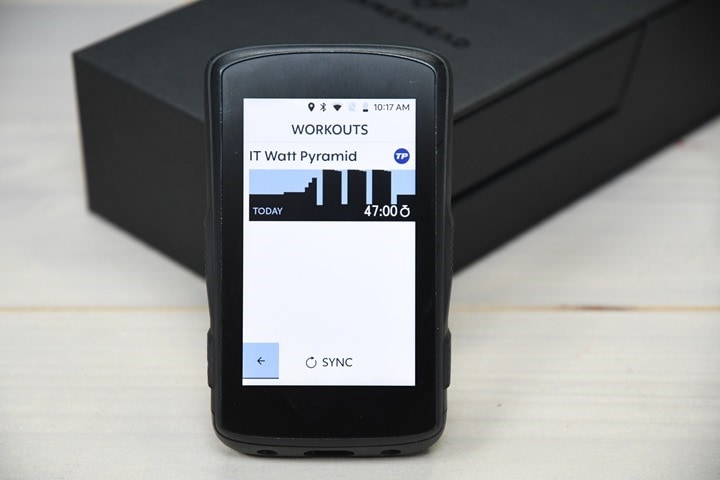
Also, I'm going to defer this to the structured workouts section lower down – where I go into far more detail.
Looking at profiles next, you can create new profiles for whatever reasons you want here. For example, I have a main profile and a trainer profile. But you could have one for race vs training, or mountain bike vs road bike. They simply allow the configuration of data pages, they aren't tied to specific sensors.
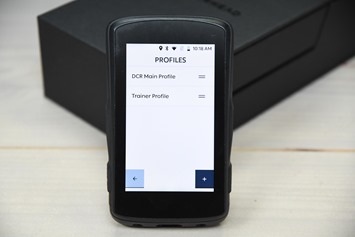
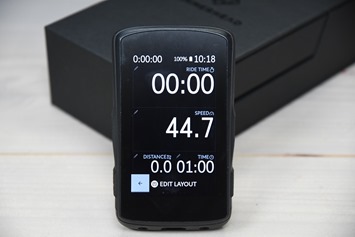
Within the data page views, you can have numerous data pages, each with up to a dozen data fields. Data fields can be traditional fields with just simple numbers, or they can be graph/chart like fields. I like that in this setup page it shows fake data (err…simulated data), as it gives you a better idea of what the data will look like later. It's a nice touch.
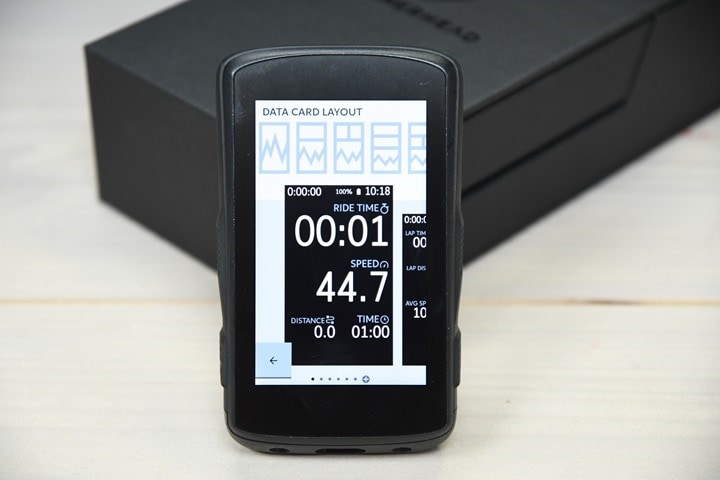
Also in the list of things I like, is Hammerhead's documentation in the profile/data page area. Seriously, it's mind-bogglingly extensive. With every data field listed (no biggie), but also seemingly every combination of data field layouts. Super well done.
However, one caveat is that you can't quite customize everything as it might seem. For example, there's no structured workout data field/page customization. It's take it or leave it. So if you do structured workouts for example, you can't customize it to show your heart rate on that data page. Just the stock power/cadence/target. It's not terribly ideal. Thankfully, that's an easy thing for them to address, also, it's something I discuss in a later section.
Next we've got sensors, but I'm not gonna take the wind out of my own sail at this point, since there's an entire dedicated section on that too. I know, I know…but hey – we gotta have sections otherwise this wall of text is even less approachable. So let's talk settings!

There's a slew of settings in here, rather than take screenshots of them all, let me just summarize:
Hammerhead Account: This is where you connect your user profile to the device, it's ultimately what stores everything here
Strava Live Segments: You'll manually enable/disable segments here. I dislike this part a lot.
Rider Profile: You can change your age/gender/weight here, as well as whether or not you're a 'lifetime athlete'.
Connected Services: It'll show you which platforms are connected (e.g. Strava), as well as whether rides auto-upload or not
Bikes: You can specify a bike and odometer here. These are then selectable post-ride.
Training Zones: You can specify both heart rate and power zones, as well as auto-calculate them based on FTP and resting/Max HR.
Turn by Turn Directions: This controls your TBT overlay options
Key Button Icons: It'll toggle on-screen labels for the buttons
Offline Maps: It's here you can configure which maps are downloaded to the device
WiFi: Connect WiFi networks
Sensors: Pair ANT+ & Bluetooth Smart sensors
Phone Pairing: It's here you'll pair up your iOS or Android device for smartphone notifications (e.g. texts)
Bluetooth Audio: You can pair up a Bluetooth headset or such for turn by turn directions
Cellular Data: If you insert a SIM card, you can control those settings here
Airplane Mode: Self-explanatory
Date & Time: Choose to override automatic network time with manual time
Auto-Pause: If you stop on a ride, it'll automatically pause
Battery Save: This will decrease usage to optimize battery, it's auto-offered below 20% battery
Elevation Calibration: This lets you manually override the elevation at your current point
Nacho Cheese Status: This indicates whether there is a nacho cheese dispenser nearby or not
Display: This controls the brightness level, as well as sleep settings (default is 5 minutes of inactivity and it goes to sleep)
Live Tracking: If you've got a SIM card or WiFi hotspot, you can enable live tracking here
Audio Alerts: This is where you control all the beeps
Are we done yet: Dear god why did I decide to write all these out
Measurements: This lets you select between Imperial and Metric, as well as power & cadence averaging
Storage: This shows how much space you have left
Factory Data Reset: It resets the whole thing
System Update: It gets new things from the magic of the cloud
About: Shows the current firmware levels
Learn more: Seriously, there's nothing left to learn after reading this review. Just ignore this button.
One minor notable in the settings, is that your toggling the lifetime athlete option, which is used for calculating calories, is based on FirstBeat algorithms. Like many companies in the space, Hammerhead leverages Firstbeat for some of their physio bits, in this case just calories.
Update – Dec 29th, 2020: Hammerhead has contacted me to note this is an error in their UI, and they do not license or use FirstBeat algorithms in their products. This UI element should be removed in the next update.
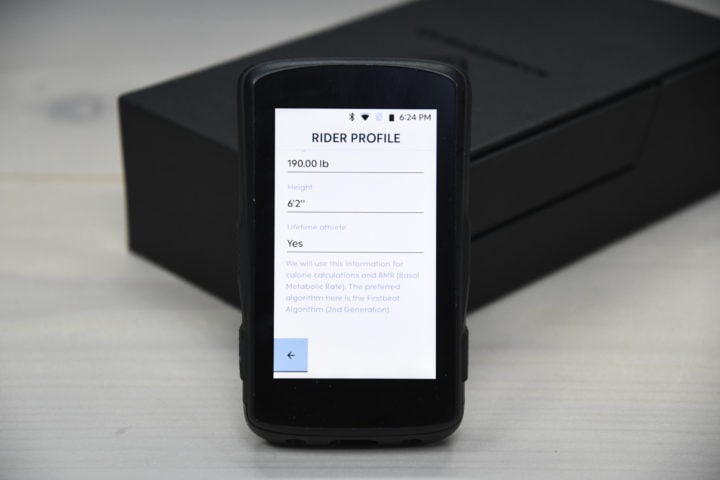
Now, let's talk about phone pairing and audio alerts. A major new feature of the Karoo 2 is the ability to pair your smartphone to the Karoo 2 to get smartphone notifications, such as texts or phone call alerts. To enable this you'll swipe 19 times through the settings to find the Phone Pairing menu, and then toggle it:
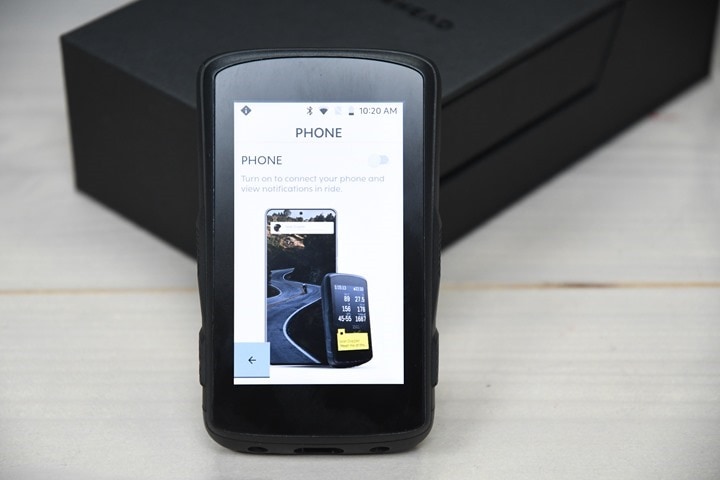
Next, on your smartphone (iOS in my case) go and find the Karoo 2 at the bottom, and pair to it – just like you'd pair to a car stereo. You'll get prompted for a pin code, which shows up on your Karo 2:
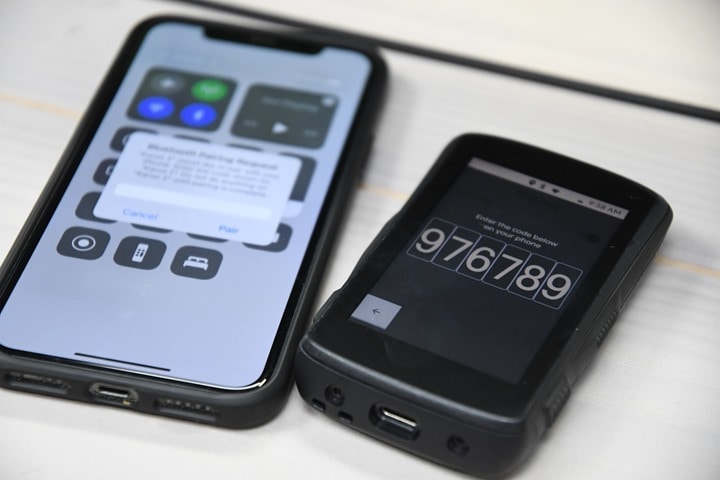
Once that's done, you can enable which things will notify you on your Karoo 2, mid-ride. So for example you can toggle phone calls and messages only, but not other apps or voice mails:

This is the only phone integration at this time. There's no syncing of data or such via your phone, only via WiFi or SIM card in the device.
Also new are the audio alerts, as the Karoo 2 now has a beeper. In the settings you can toggle which beeps are beeped for which beeping things:
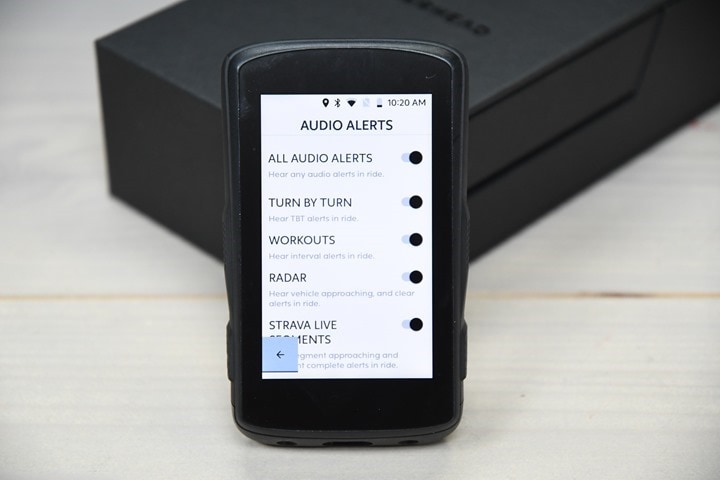
However, despite these settings – to be honest, all the beeps kinda blur together. Especially when you've got Varia radar enabled while doing turn by turn navigation. It's just a never-ending beeping good time. And while there are nuanced differences, I think they need slightly less nuance. Just my two cents.
Now, about that mount, it's easy enough to install.
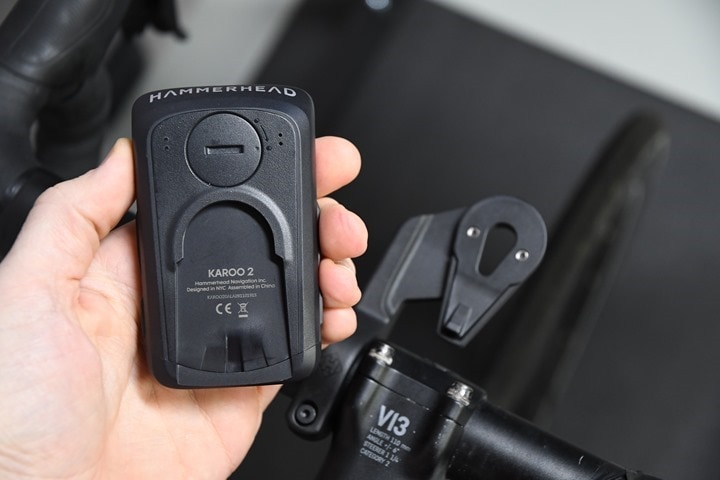
To insert the Karoo, you slide it straight in (I show it in my video), and then to dismount the Karoo, you rotate it slightly and pull it out. This is slightly advantageous for tighter fit situations (such as aerobars, though…this mount won't work on aerobars).
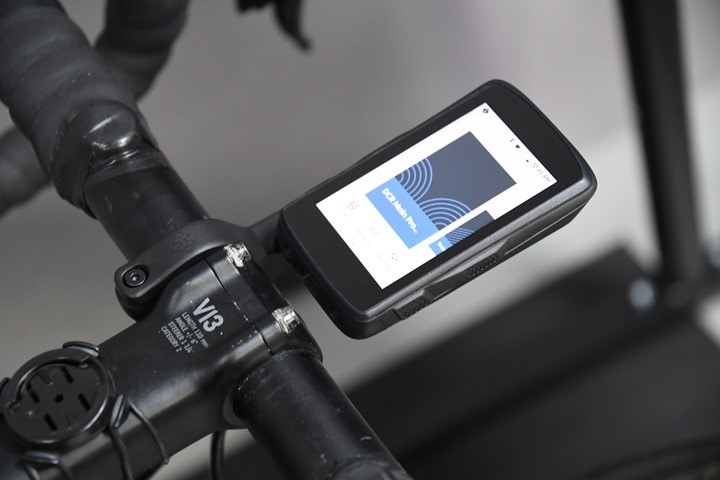
They also included in the pre-order units a small adapter that makes it compatible with Garmin mounts:
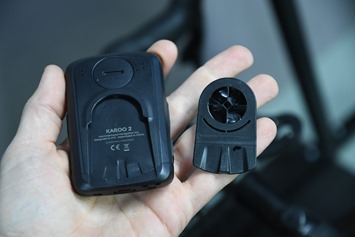
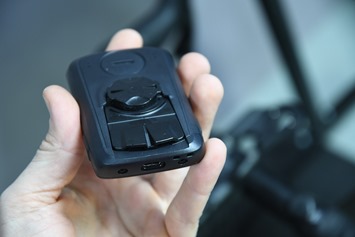
Also, since we're on the back of the unit, here's where you install a SIM card:
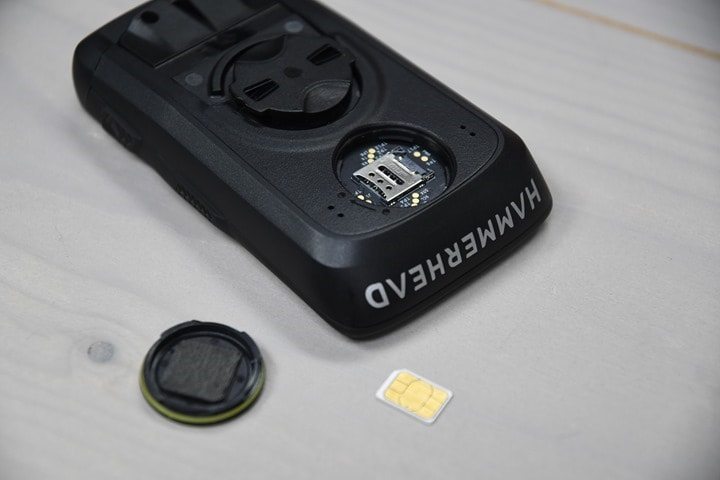
You don't have to install a SIM card, and I only had it installed for a single ride. But it does then allow LiveTracking, as well as any other function you want that you'd normally do via WiFi (like syncing rides).
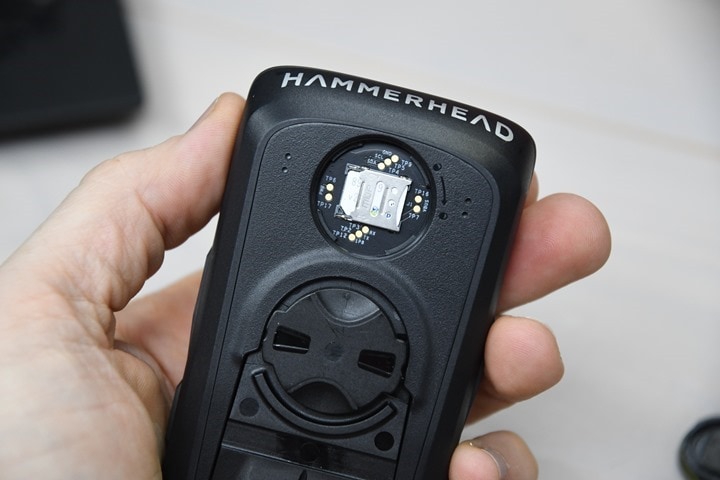
Ok – for the love of all things, let's finally start riding. That was the intent of this section before I got all distracted with settings and configuration. Simply tap your ride profile of choice (such as road bike or such, whatever you named them), and you'll be brought here:
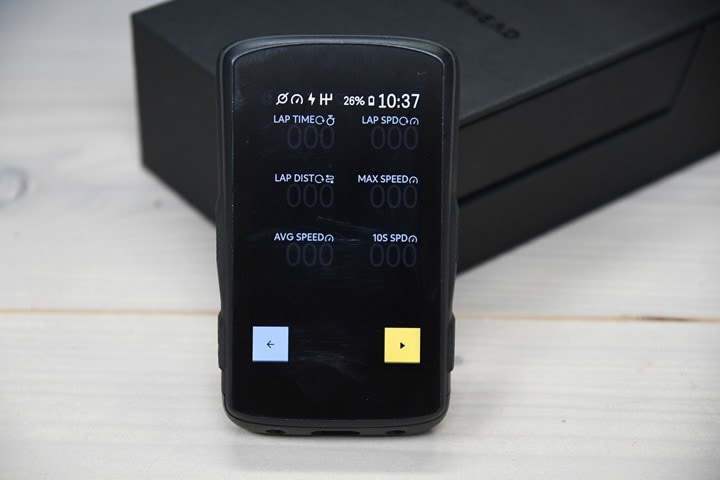
At this point the ride hasn't started yet. Like most units, you'll manually start it once you're ready. The paired sensors will show along the top, such as power, shifting, or cadence. You'll also see your battery stats and the time of day on that upper line. Meanwhile, you can swipe through your data pages left and right using the touchscreen, or, you can use the upper left and right buttons to change data pages.
Here's a gallery of data pages during one of my recent outdoor rides, showing some of what things look like.
Notable in there is Garmin Varia Radar support. That'll show along the left side of the screen (currently not configurable though to the right side of the screen for people driving/riding on the wrong side of the road).
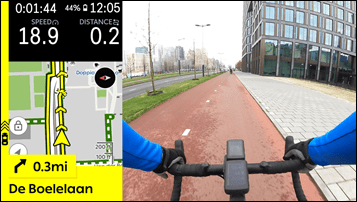
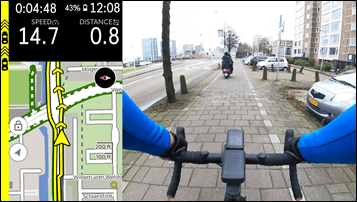
I dive into how the Varia Radar integration works on Karoo units here.
In terms of usability during the ride, all in all it works pretty well. I find that the touchscreen swipes generally work good when it's dry, but not quite as good when it gets wet. For example, on a recent trainer ride with standing sweat on the screen, some of the touches weren't as responsive (like changing intensity of the trainer). I'd say it's about 80% success rate with water or gloves, check out the video where I show some examples.
Still, the vast majority of core ride actions can be done via the buttons if you want to. Visibility is good in gloomier Netherlands almost-winter weather, though in brighter weather earlier this past fall I found the screen really required you bump up the brightness to get it as visible as I wanted it. Not a big deal, but that'll burn more battery.
If you've got Live Tracking enabled (requires either SIM or WiFi hotspot), you can send the tracking link out to friends or family to track your ride. I tried to use it this morning, but it wouldn't show on my computer. Later in the afternoon I tried and could access the tracking page from a different computer (all of one foot away from the first computer that it still doesn't work on). So it looks like I'll have to try again.

After your ride is complete you'll get a small summary screen. Like with the earlier historical rides page – this could use some UI love. I would love to see a ride elevation profile, or a mini map, or time in zone…or…anything really.
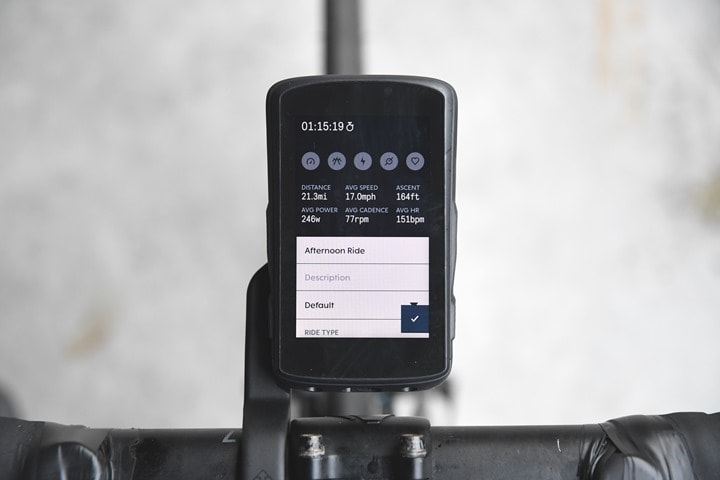
One feature that is kinda nifty though is that you can type the title of your Strava ride here, and it'll convey that title to Strava. In my case, I upload all rides to Strava as private, and then manually update the title and add a photo. But I used to be in the camp of upload and call it done – so I can appreciate that.
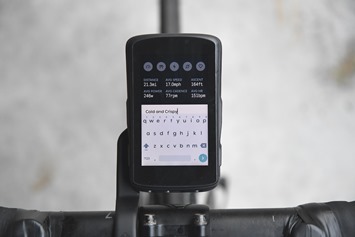
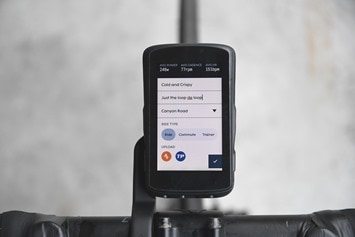
As far as battery usage goes, it's honestly a bit hard for me to judge this one. Almost all of my rides had screen recording software on them, save a few recent rides. That screen recording software doubles the battery burn. Seriously, I measured it (it writes it to the .FIT file). So, looking at the data that I have, with the screen brightness for today's 75 minute ride at about 20% (it was an overcast day), the battery burn was 12.46%/hour, thus, ~8hrs. That's paired to a power meter, heart rate sensor, and Varia radar (though, very low traffic since I was out in the middle of nowhere). It was navigating a course at the time, but the vast majority of the ride it was on regular data field pages, not the map page. Thus, 8 hours is seemingly short of the claimed 12 hours.
Also, I have been having some issues with charging. I'm working with Hammerhead to figure those out, but essentially some chargers that should absolutely charge super fast, are barely charging at 1% every hour (such as a MacBook charger, and a heavy duty drone charger, both with USB-C PD). I'll circle back once I finish testing the 4 different units I now have against all the charging cables/sources. Some do charge just fine, but not the ones I'd have expected.
Now, before we dive deeper into navigation – I need somewhere to mention that the Hammerhead Karoo 2 is built atop Android, but that doesn't necessarily mean it's the same Android experience as your Samsung phone. Rather, it's a fully closed up device, so that means you won't have the Google Play store on there to easily load Strava or Netflix.
But that doesn't mean you can't. With even just a minor amount of technical know-how you can sideload 3rd party apps (I wrote some instructions here). I've loaded a few, for example, Zwift's Companion app:
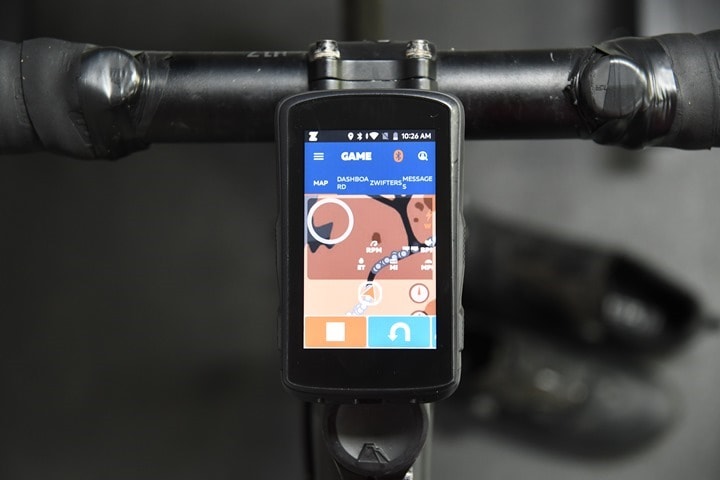
And here's the TrainerRoad app loaded, and paired to my Tacx NEO 2T trainer and the HR from a Garmin FR745 (broadcasting ):
):
And, if you want to see a short video of that, here's me opening the TrainerRoad app, looking at the sensors available, the paired ones, and then selecting a workout and starting it. In this case it's controlling the NEO 2T. You'll see the wattage is a bit wobbly at first, but then I shift into the smaller ring and it stabilizes like any other trainer (no relation to the Karoo 2).
Hammerhead's ultimate goal here has been to get/convince 3rd party companies to write apps for their platform (via an SDK they have), helping to bridge some of the feature gaps, or, by giving a more compelling experience. That's been the goal since Hammerhead first announced the original Karoo 1 years ago. And at present, no companies have bit – largely because till now, I don't think most companies have seen Hammerhead as viably competitive.
But that sentiment is changing (rightfully so), and it sounds like there's some very near-term announcements that will be made in this space, for some meaningful 3rd party integrations/apps. I'm excited about them, though I remain someone skeptical on how many companies/apps Hammerhead will be able to convince to write versions for the Karoo.
While it gives those companies massive display flexibility compared to Garmin Connect IQ, Hammerhead obviously has not even 1% the user base of Garmin Edge users (probably not even 1/10th of 1%). Certainly, that's going to change in 2021, but it's going to require a leap of faith on behalf of those companies to see the potential beyond just user base numbers. Like most situations, I expect smaller apps/platforms will be the first – and then if the user base grows quickly, others might find ways or the desire to integrate.
Mapping & Navigation:
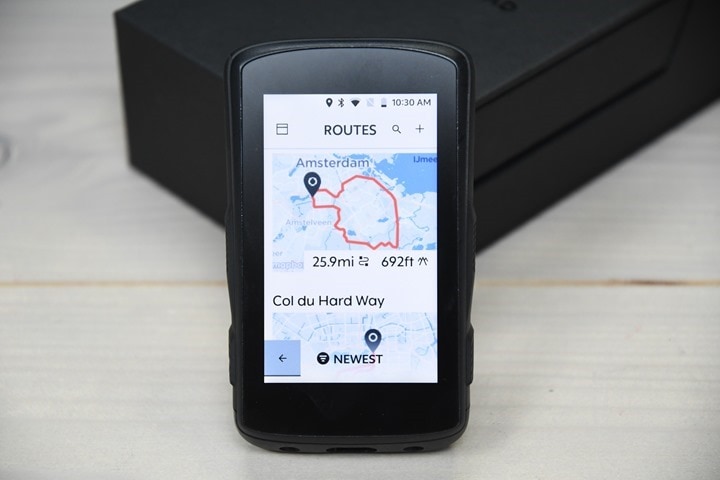
There's no question that if you're buying a Karoo 2, it's likely because you often like to navigate with your bike computer. Which isn't to say that you shouldn't buy the Karoo 2 if you're not into navigation, but simply that it's where the Karoo series is and always has been the strongest.
To start with routing, you've got two core options You can connect it up to routing providers like Strava, Komoot, or RideWithGPS – or you can create routes ad hoc using the online web builder. Also, you can create routes on the device as well, but only if you have an active internet connection (SIM card or WiFi). Here's the routes dashboard on Hammerhead's site:

To create a new route you've got two options: Manually just click your way through the map, or import a route. For routes, you can actually even just put in the URL of the website (which works for Strava, RideWithGPS, Komoot, TrainingPeaks, BikeMap, Google Maps, and any website URL that ends with .GPX). How cool is that? Or, you can simply upload the original file. Seriously, it's super flexible.

You can also use their route builder online, but honestly, my attempts haven't been great here. Take for example the below route between those two points. It ignores the massive cycle-highway that basically exists alongside the southern edge of the rowing basin, forcing me off onto minor cycling paths no matter what I try.

Now I get it – the bicycle networks of the Netherlands are legendary, and many companies have challenges – but this is a very straightforward case that every other GPS unit I've tried can map this properly on the most direct (and most bike friendly) path.
Still, some routes render just fine. For example, this one in the opposite direction worked pretty easily. Then again, it's a lollipop loop with only one way in and one way out.

You can also add waypoints as well, such as this windmill:

Once you click to Save, seconds later it's on the device. It's super quick. Similarly, up above in the screenshot of the dashboard you'll have noticed the Strava logo on routes, which means it came from Strava. As long as you favorite a Strava route, it'll automatically show up here.
Once we've selected a route it'll show you a preview of that route, as well as the elevation. Though, I'm not entirely clear where the elevation is coming from on this route. It's literally the pancake of the Netherlands with a single overpass (once). Afterwards, it showed a mere 103ft of elevation gain (twice up the bridge).
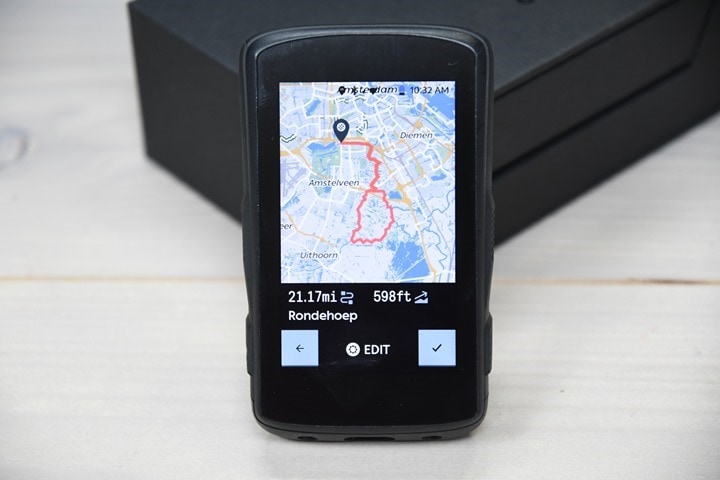
Once you've pulled open the route it'll show the route on the map with directional arrows, as well as your current location. You can see a few examples of that during a recent ride below:

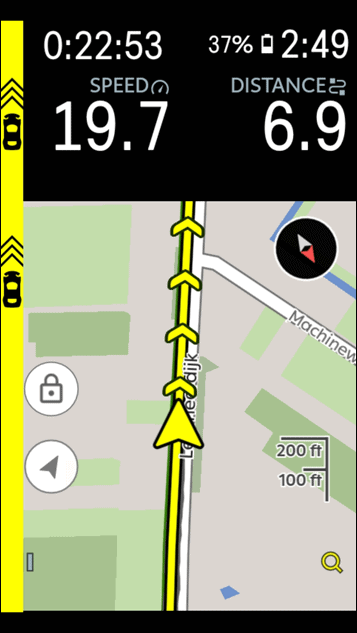
If on the map page, as you approach a turn, you'll get a banner that displays the distance until the turn, as well as the directional information, like these:
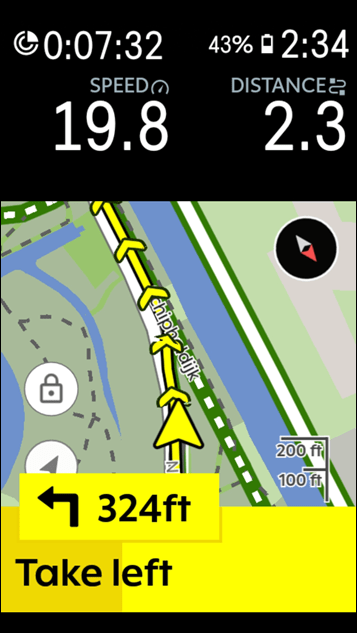
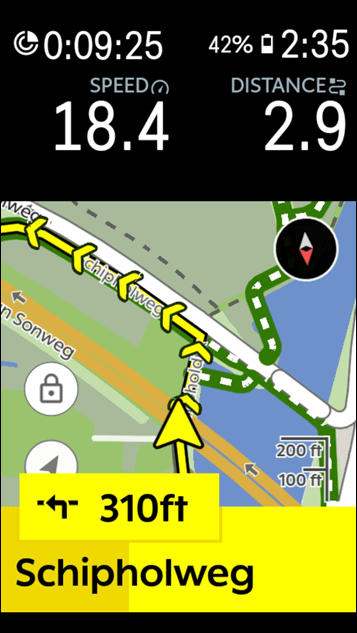
Whereas if you're not on the map page, you'll just a pop-up with the same turn information (see below).
While this generally works the vast majority of the time, I find the routing just isn't quite as good/accurate as Garmin's. Namely in cases where the Karoo thinks I'm turning, but in reality aren't. These are so-called phantom turns, where usually it's just a bike path changing names, but often times the path might slightly dip a few meters (literally, just a couple meters) to the left or right around a driveway. But these can often trip-up the Karoo into thinking there are big turns:
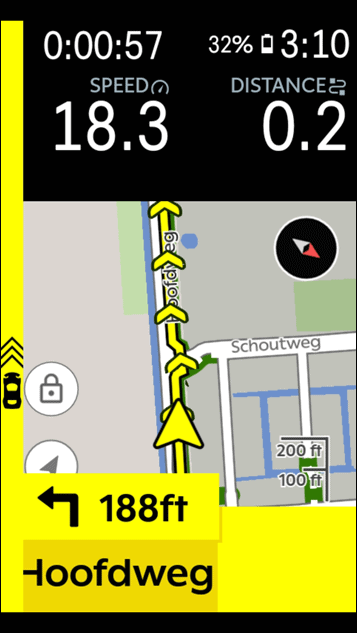
This results in two issues, namely if you aren't on the map page at all times. That's because there is no mini-map on the other data pages, it doesn't show any pop-up of mapping context for what's about to happen. It just shows the turn textually (like below).
And that's a problem when there's either a legit phantom error, or, in this particular case – my routing having a single data point a few dozen meters down one street. I turned, thinking I needed to turn, but in reality, it was just a misplaced dot of mine.

If I was in the map view, I would have seen that, or if a mini-map popped up, it'd have been apparent. Unfortunately, neither were true. And what followed originally started as my fault, but quickly escalated.
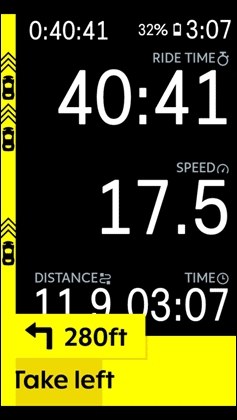

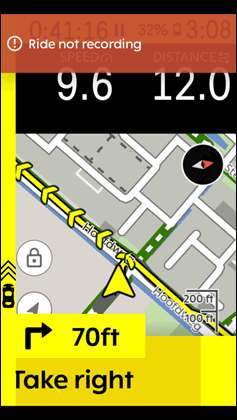
Somehow as part of trying to undo my failed keeping straight plan, the ride stopped recording. Hammerhead believes I paused while trying to change back to the map page to figure out why it was upset at me…all while trying not to get hit by gigantic green farm equipment. This explains the 'Ride not recording' banner up top (3rd photo above). But that covers the paused icon below it barely visible. I'm not sure why it just doesn't say 'Ride Paused', since that's more clear than 'Ride not recording' – which basically sounds like something has gone horribly wrong technically.
But how did I end the ride you ask? Well, that's a funny story. See, normally you start a ride by pressing the lower right button (see 1st screenshot below). So first I figured I'd get myself back across the street and then resume the ride. So as I crossed the street (1st image left), seeing it was paused I instinctively tapped the right button to resume. Except one problem: During that few seconds crossing the street, it then showed the 'Slide to end ride' (center image). Now what? Well, I knew that sliding that screen would be bad, so I figured the same lower right button would also resume.
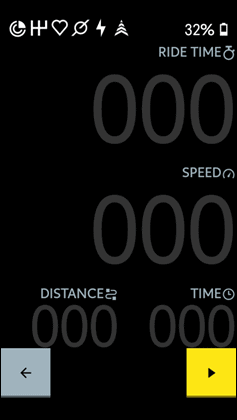
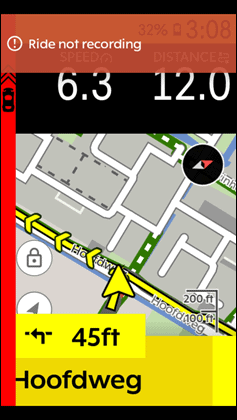
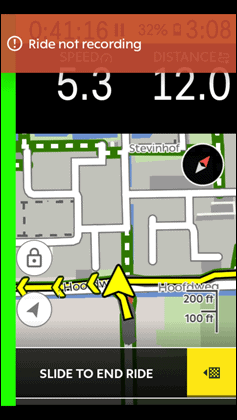
I was wrong. It ended it. Donezo. And there's no confirmation or anything. It's just over.
There's two reasons for that:
A) Because 'Start' isn't the same as 'Resume'. Once you start, those buttons switch, so that the bottom right start button becomes the lap button, and the pause/resume button switch to the other side (bottom left). And once you stop, Lap becomes 'End ride now".
B) "Slide to end ride" also now means "Or just press the side button" after a few seconds.
That's because Hammerhead recently made it so a slide wasn't required, in case the touchscreen isn't responding well with gloves/rain/snow/whatever. But without a safety check on that, you can get in trouble quickly. I'd eventually use FitFileTools.com to merge the two parts of the ride together.
And look – let's say I take complete responsibility for not fully understanding that the pause/resume button becomes the 'Death to Ride' button after some period of time. My bad. Or that my Strava route had an errant point. Also my bad.
However, I think it shows that as forward as Hammerhead's UI is, the above center screenshot is a literal dumpster fire of user interface. No really, it looks like it's on fire. Some of that is exaggerated by Varia Radar data, but a lot of it is just too much. Why is the gigantic 'Ride not recording' bar atop covering up a paused icon? Those two are duplicate. The very verbiage of Ride Not Recording implies the recording went wrong, not that it's simply paused. And if the ride isn't recording, then why are you still telling me turn by turn instructions? And then under that entire mess is sitting the Slide to End Ride – hidden by the instructions. And finally, why on earth are the start/resume/pause buttons switched once you start a ride? I can't think of a single other device I've ever reviewed that switches those. I guess that's why they aren't actually labeled on the exterior buttons themselves.
Ok, my rant temporarily over (and I'm writing this 6 days later) – these incidents are rare. I haven't managed to shoot myself in the foot on any other rides, though incorrect navigation instructions do happen multiple times every ride. All of them tend to be minor, but all of them require you to be on the map page at all times. That's because unlike Wahoo/Sigma/Garmin, Hammerhead doesn't pop-over a mini-map upcoming turn page when you're on another data page. It just shows the turn/street text information. You can see screenshots of the pop-over in this section, but it's the same on all Garmin devices.
Ok…moving along to something they do really well – their Strava Live Segments page. It'll sync your Segments automatically to your account once favorited on Strava. While previously that wasn't syncing (and enabling) my favorites, it does appear to be doing it today, so I'm happy now.
Out on the road, you'll see a message about an upcoming Strava Segment appear:
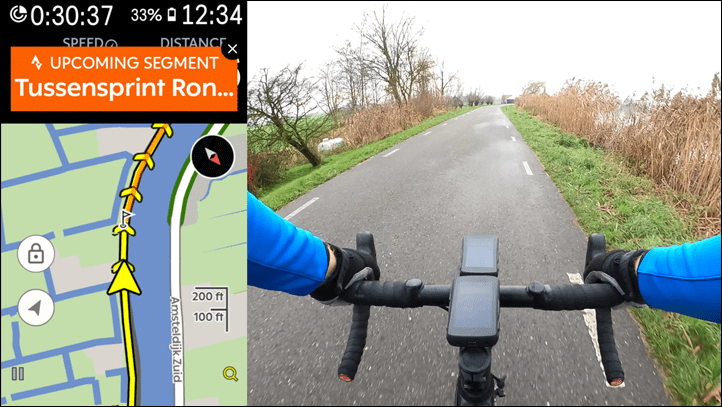
Once in the segment you'll get an overlay along the bottom that shows the time in the segment, the time completed (left side), time remaining (right side), and then various icons indicating different goals – such as the KOM/QOM, your nearest competitor, your PR, etc…
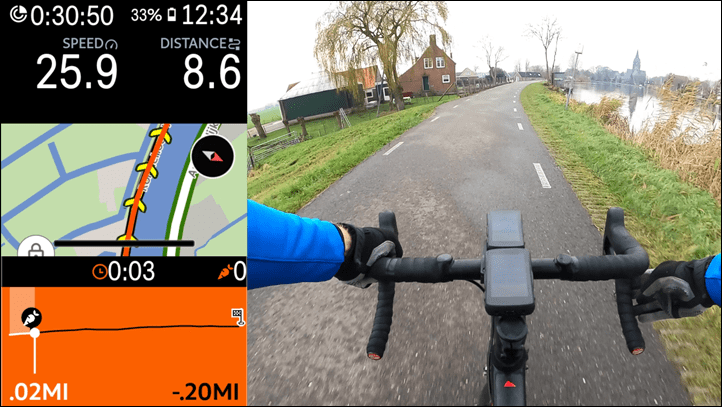
These icons become clearer once you get a bit more into the segment. Also, there's an elevation profile there as that line, but I don't really have any elevation here.
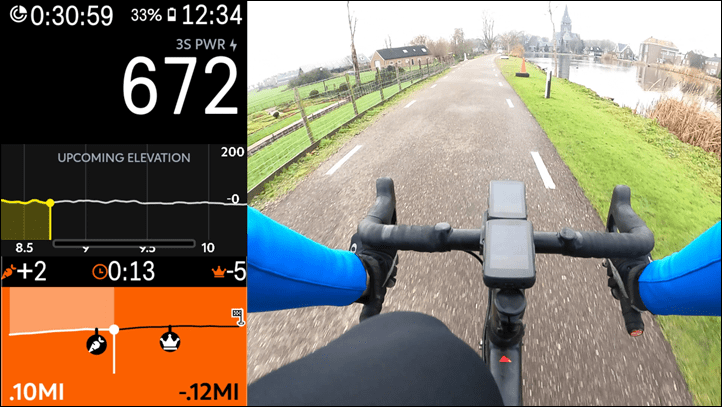
At the end, it'll list any achievements you unlock – in this case the carrot, which is basically the best effort recorded by my nearest competitor.
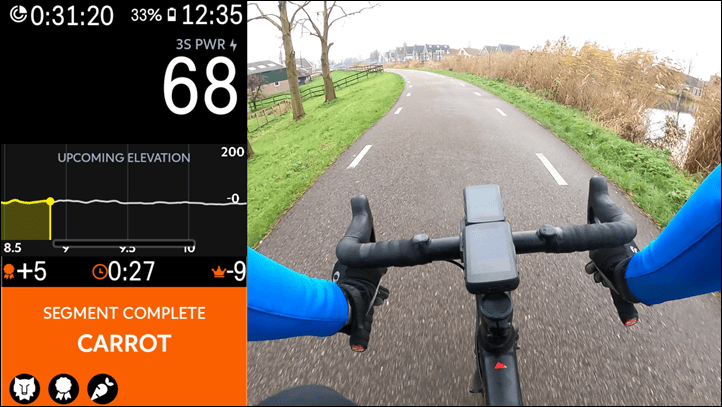
Except, I wish it would tell me who the heck that was, since I've got no idea. So instead, I have to go onto Strava later on and play detective and figure it out. Turns out…it was Lama. Sorry Lama.

(Side note: I can guarantee you that once Lama is able to travel again, you know he's going to come back and just rampage around my regular loop to ensure I can't keep using his name this side of a record.)
Also note that you can indeed have overlapping Strava Segments, it'll properly show both, and you can then swipe left/right between the different segments. Like I said – I really like much of the implementation here, and with a few tiny tweaks it'd be incredible.
Structured Training & Sensors:
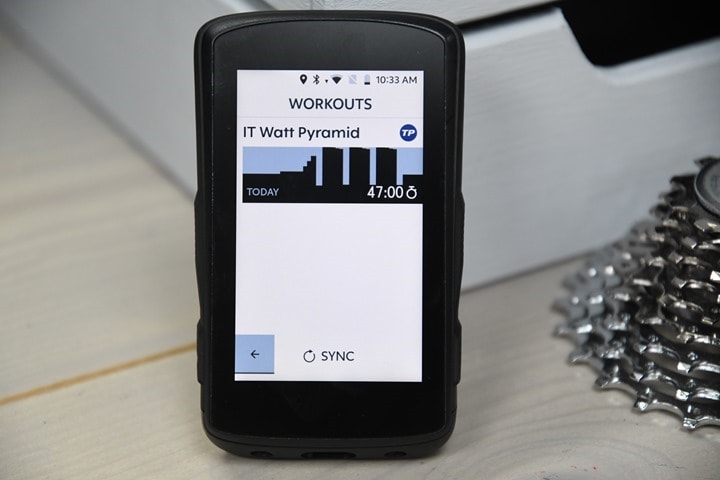
The Karoo 2 supports syncing structured workouts from TrainingPeaks, enabling you to complete structured workouts both inside and outside on the Karoo 2. Moreover, it also supports ANT+ FE-C trainers, so it can automate these workouts for you on your smart trainer (all of them support ANT+ FE-C these days).
And that gets into the sensors side of things. The Karoo 2 supports ANT+ & Bluetooth sensors, including almost every sensor type you're likely to have on your bike. Also, internally the Karoo 2 has a barometric altimeter, as well as GPS of course.
We'll start off with the structured training aspect. As of this time, the only platform that Hammerhead supports is TrainingPeaks, which means that you'll need an account there in order to use structured training on the Karoo 2. While there have been some rumors and screenshots floating around of TrainerRoad integration, that hasn't happened yet – and when asked, there isn't a timeframe for that at this point. There also isn't a method of just side-loading a workout manually, if you happen to have the structured workout file.
In any case, once you've linked your TrainingPeaks account to the Hammerhead dashboard, it'll start syncing structured workouts per your calendar. Meaning, it won't sync your TrainingPeaks library of workouts, just those that are on your upcoming calendar in the days ahead. So in my case as I primarily use TrainerRoad for my structured workouts, I went ahead and manually dragged the one structured workout I have in my TrainingPeaks library onto Monday:

Then, you'll see it showing up on the Karoo 2 automatically. If it doesn't appear at first, just hit the sync button at the bottom to re-sync via WiFi:
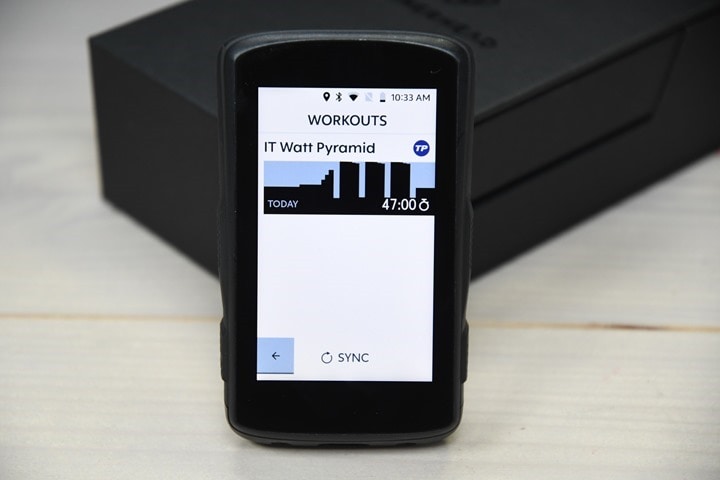
You can then tap the workout to get a highly distorted view of it. This is because they try and scale vertically, versus just leaving it like the preview, and instead putting some other random info/text below it (for example, they could put the estimated TSS, power zone compilation, number of tacos required, etc…).
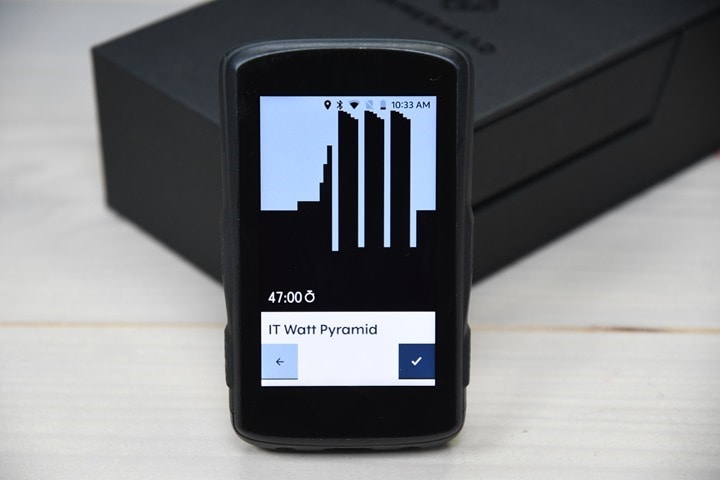
In any case, you can select to open your profile now and get ready to start. However, you'll likely want to disable your GPS first. Unfortunately the Karoo series don't have any way to turn off the GPS automatically if you're indoors on a trainer (or, via a certain ride profile). In my case, I created a trainer ride profile, but I still need to manually swipe down, long hold 'Sensors', and then manually disable 'GPS'. And then – far more importantly, remember to enable it next time for my next outdoor ride.
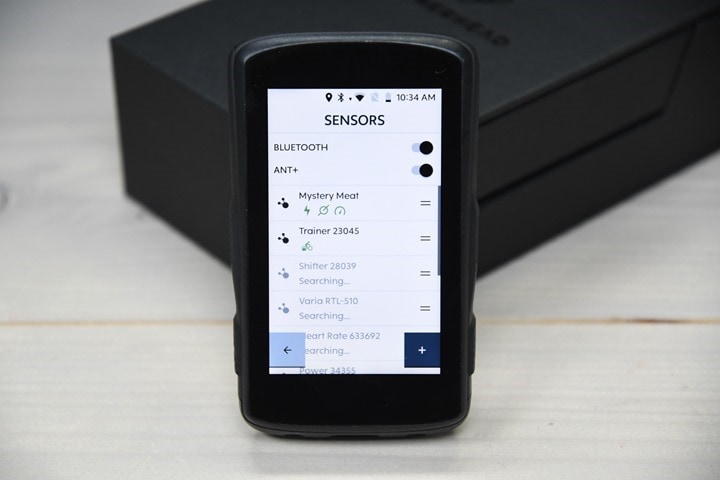
With that, we're ready to begin. You can see here the workout screen ready to roll:

It'll now automatically control the trainer in ERG mode, keeping it at the mid-point of the wattage target ranges I had created.
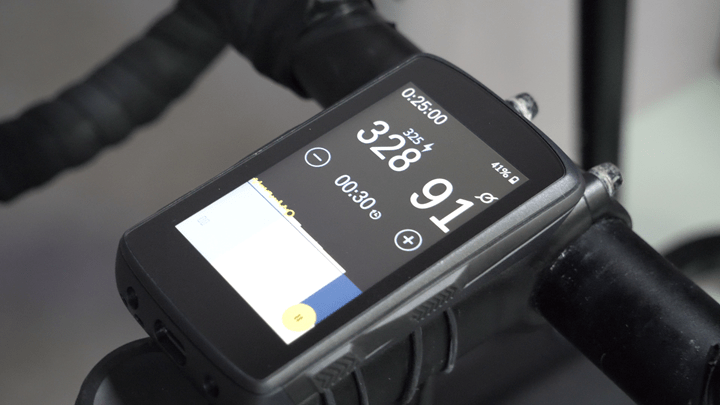
Note that there's *no need* for this workout to be executed only indoors. You can in fact do workouts outside on the road as well. In fact, you can even add a structured workout to ride at any time. So for example, let's say you've got a 15-minute ride to get to where you want to start your structured workout (perhaps past stoplights and such). You can start recording your ride, and then later open up the workouts page and add the workout.
Both indoors and outdoors, the Karoo 2 will automatically create lap markers for each new section of the structured workout (such as a new interval). That way these are visible on all training platforms later on, including TrainingPeaks. Indoors on a trainer, you can also tap the +/- on the workout page to increase or decrease the target power in 5% increments. However, the only place you can see the entirety of the workout is at the end. I wish there was a bit more context beyond just that interval.
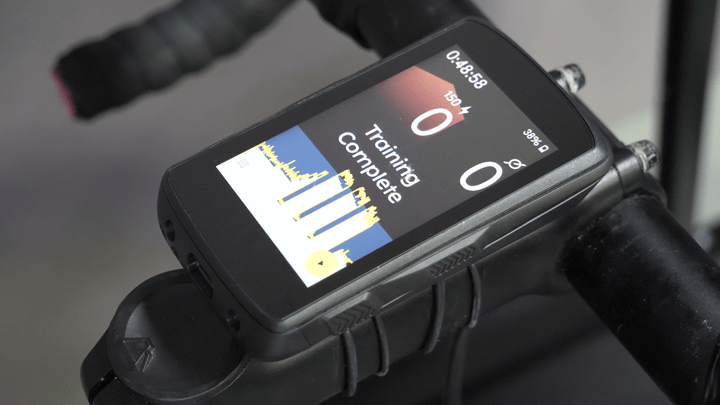
Both indoors and outdoors you can pause the workout (without pausing the ride), and then once paused you can skip or reset a given interval (such as if you hit a stoplight and need to reset).
Once you're done with your workout, you'll get a summary of it like normal. Meanwhile, up on TrainingPeaks, you'll get the planned workout with the completed workout merged together:

Ultimately, all of this works pretty well – and largely in line with how their competitors do structured workouts. The main area that Hammerhead could improve here a bit though is customization of workout data fields. There isn't any way to add workout data fields (like 'time remaining in an interval') to other data pages. All of the structured workout pieces are only available on a single non-customizable workout page. So if you don't like that layout you're outta luck. Still, in the grand scheme of things – that's fairly minor.
Next, let's talk sensors. The Karoo 2 supports pairing to numerous sensor types, and supports the saving and naming of multiple sensors per type. Meaning, you can save 3 power meters and name them for each of your bikes if you want to. Or 15 power meters if you're me. Whatever floats your boat.
Here's the complete listing of ANT+ & Bluetooth Smart sensor types:
– ANT+ & Bluetooth Smart Heart Rate Sensors
– ANT+ & Bluetooth Smart Cycling Cadence Sensors
– ANT+ & Bluetooth Smart Cycling Speed Sensors
– ANT+ & Bluetooth Smart Cycling Power Meters
– ANT+ FE-C Smart Trainers
– ANT+ Cycling Radar (Garmin Varia radar units)
– ANT+ Gear Shifting (SRAM eTAP, Campagnolo EPS)
– Shimano Di2 Shifting
This is the vast majority of types of sensors people would likely have. About the only mainstream type it doesn't yet support are ANT+ lights (which would include Cycliq, Garmin, Bontrager, See.Sense, and others). It also doesn't support some of the more niche sensor types like tire pressure sensors (Quarq), or Muscle Oxygen (Moxy). I don't see this as critical path, but rather things that Hammerhead needs to balance with everything else.
To add a sensor you'll tap sensors from the bottom of the dashboard, which takes you into the sensors page. It's here that you can filter by ANT+ or Bluetooth Smart sensors, as well as see any sensors listed with icons showing ANT+ or Bluetooth Smart:
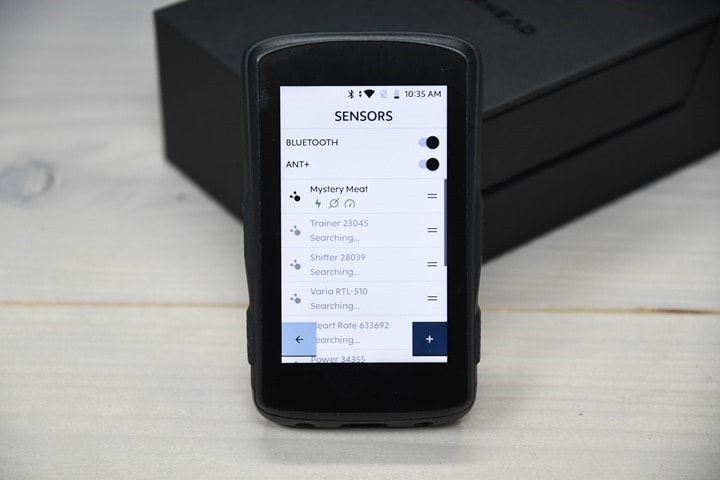
To pair a new sensor you'll hit the '+' in the lower right corner, which then lets you search by ANT+/BLE/Di2 (technically speaking Di2 uses private-ANT and not ANT+, which is why they've categorized it differently).
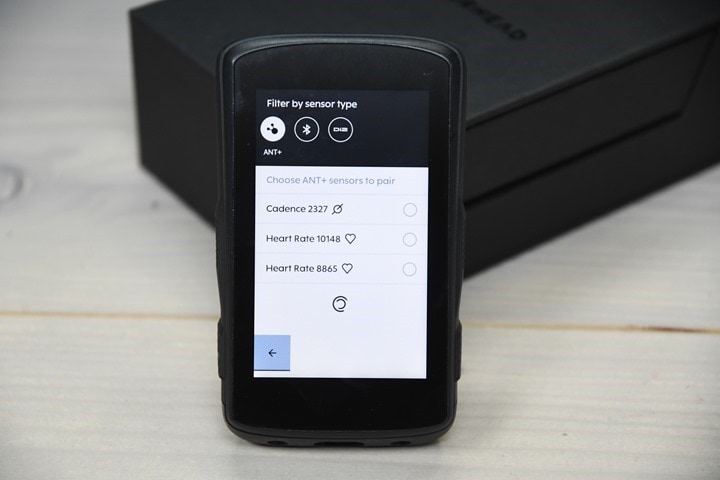
You can tap on a sensor to give it a friendly name if you want, or, just leave the default ID. Your call.
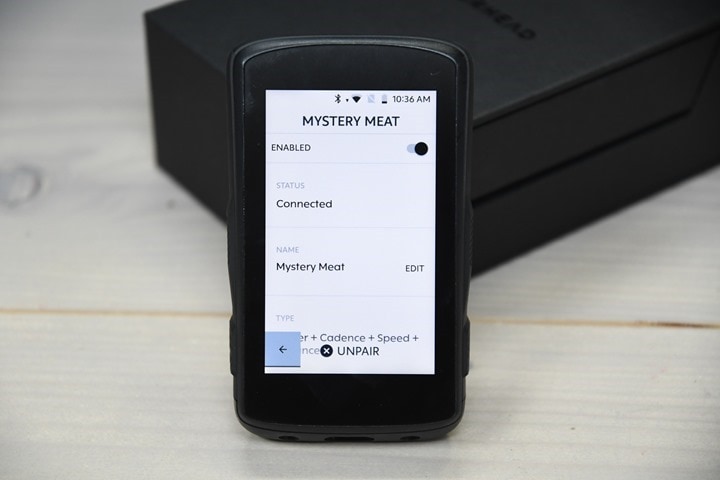
I've been dual-recording the vast majority of my rides (indoors and outside) to validate that the sensor data collected by the Karoo 2 matches that of other units, and so far I haven't seen any discrepancies there. Note that I cover GPS data in this next section however. First though:
Complete User Interface Tour:
What's that, you want a 30-minute long video to go with your 8,931 word in-depth review? Yes, another video aside from the other 15-minute video? Ask not and you shall receive anyway.
In the above video I go through the following things:
1) Complete unboxing
2) Size and weight comparison to popular/competitor units
3) Complete user interface tour indoors
4) Detailed ride-along user interface explainer as I ride across the countryside (including navigation/Strava Segments/Data pages and more)
You can use the YouTube chapters feature if you drag along the bottom to find the section you want. Give the video a like on YouTube if you found it useful.
Also, this is a great time to point out how incredibly easy it is to make the outdoor sections of that video given that I can load screen recording software on the Karoo series (since it's just Android). I would love to see such a capability on other units, as it makes not just my job easier, but makes it far easier for people to share ride type videos online to increase popularity of a product. Just sayin'…
GPS Accuracy:

There's likely no topic that stirs as much discussion and passion as GPS accuracy. A watch could fall apart and give you dire electrical shocks while doing so, but if it shows you on the wrong side of the road? Oh hell no, bring on the fury of the internet!
GPS accuracy can be looked at in a number of different ways, but I prefer to look at it using a number of devices in real-world scenarios across a vast number of activities. I use 2-6 other devices at once, trying to get a clear picture of how a given set of devices handles conditions on a certain day. Conditions include everything from tree/building cover to weather.
Over the years I've continued to tweak my GPS testing methodology. For example, I try to not place two units next to each other on my wrists, as that can impact signal. In the case of GPS bike computers, I put multiple units on my handlebars, though quite well separated (such as one on an out-front mount, another on the stem, and others to the side of the handlebars).
Next, as noted, I use just my daily training routes. Using a single route over and over again isn't really indicative of real-world conditions, it's just indicative of one route. The workouts you see here are just my normal daily rides/workout. At least as much as is possible in this COVID-19 world without being able to travel far, I've varied my workouts and terrain (cities/buildings, trees, quiet roads, bridges, etc…). But, given I live in a pretty flat place (Amsterdam), it means there's very little high-altitude mountain type testing right now. Maybe later this summer. Sorry!
(Now, I'll give you a spoiler since you made it thus far: By and large it's pretty rare to see GPS screw-ups on road-cycling routes. And frankly, that continues here. This section is super boring because nothing 'exciting' happened.)
First, we've got a ride from last week where I meander all around the countryside, including numerous tunnels/bridges – even under airport taxiways, to see how GPS handles, but also how it recovers from no-GPS situations like tunnels/bridges. In this case the Karoo 2 is compared against the Wahoo RIVAL GPS watch, Garmin FR745 GPS watch, and Bryton Rider 750 bike GPS. Here's that data set.

At a high level, no obvious error. So let's zoom in to the very start to see how initial GPS accuracy looks as we get rolling:

Basically identical. Here, zooming further into a forested section – again, everyone near identical. A tiny bit of variance from the Bryton going under the bridge, but hardly anything in that context.

Seriously, this set is so boring, they're all perfect:

So you know what we're gonna do? Throw airplanes at it. Seriously, I'm going to go under airport taxiways, under airplanes (for real), and every bridge I can find. Along with some of the tallest buildings in Amsterdam (at the airport…go figure). Still boring:

In fact, it took a simple street crossing to finally get some disagreement. The FR745 was ranked first, followed by the Karoo, and then the Bryton and Wahoo units split the difference out in the grass.

Fine – let's throw more airplanes at it. Even a runway! It still properly handles loss of GPS and picking up GPS at the tunnel exit (which is what I'm looking for here). Again the Karoo 2 and FR745 take the cake for best entry/exit.

Ok, enough airport games. The rest of this ride is boringly perfect (still).
Let's go to today's ride. This one I doubled down on Karoo 2's, with two of them. Karoo Squared. Plus a FR745 and a Wahoo RIVAL. Here's that data set:

This one I started off across the street from the hospital, and let all the units have a 30-60 seconds breather after pressing start (they all had like 10 minutes while I was shooting video to get GPS and lock firmly). About 30 seconds after I start pedaling I go under/through the Hospital. It's basically like an overpass. Zero issues from the Karoo or Garmin units.

The rest of that street I did both directions, and actually has some new high-rise buildings on all sides of it. Pretty stable across the board.
Later on, as I do some interchange stuff, including bridges, you see the tracks are near identical, except for one brief tiny disagreement from the FR745.

Later in the ride…more boringness:

Still boring:

Ok, that's a waste of time. The entire rest of the set is perfect. We need to find some bad GPS tracks here somewhere. Anywhere!
So, let's go back to Nov 6th. Over a month ago, and like 4 firmware versions ago. But gosh darn it I'm gonna find some imperfection to complain about. Here's that data set:

Look – in the trees, it's off by one meter! Actually, so are the other two units, the wrong direction. But at least we now know the Karoo 2 isn't perfect.

Actually, in all seriousness, it did struggle a little bit (four firmware versions ago) at the local cycle track loop that I did on repeat. Not hugely, but you can see it cut the inside edge of all the corners on most turns, compared to the FR745 and Wahoo RIVAL.

That said, given this was a month ago and four firmware versions ago (beta still I think), I haven't seen that since (I also haven't been back to that spot since). Point being, that's the only error I can find in my GPS tracks.
Ultimately, I'm just not seeing anything even remotely problematic of discussion in the GPS accuracy of the final production firmware for the Karoo 2. Which honestly isn't a huge surprise. I rarely see issues road-cycling with bike GPS computers. I've got some trail work I need to do over the coming weeks, so I'll see if anything changes there.
(Note: All of the charts in these accuracy portions were created using the DCR Analyzer tool. It allows you to compare power meters/trainers, heart rate, cadence, speed/pace, GPS tracks and plenty more. You can use it as well for your own gadget comparisons, more details here.)
Product Comparison:
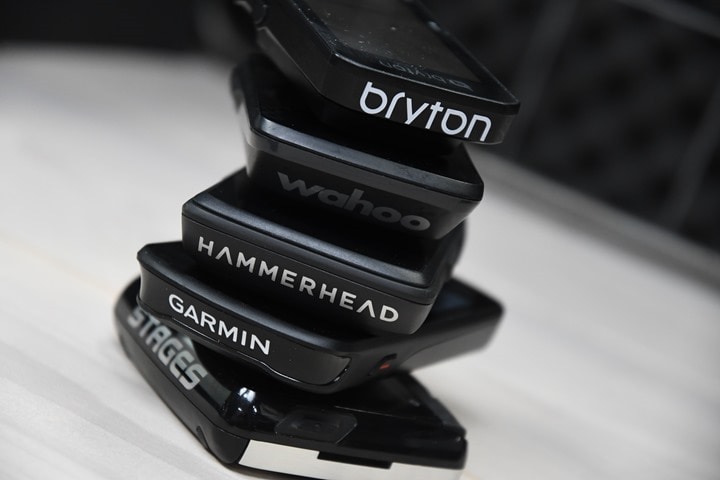
I've added the Karoo 2 into the product comparison calculator so you can see how it compares to other units on the market. To keep things simple for below, I've compared it against the Wahoo ROAM, Garmin Edge 530, and Edge 830 (all of which have routable maps onboard). Of course, there are plenty more units in the product comparison calculator, so you can make your own charts here as well. In the meantime, here's how things line-up below:
| Function/Feature | Hammerhead Karoo 2 | Wahoo ELEMNT ROAM | Garmin Edge 530 | Garmin Edge 830 |
|---|---|---|---|---|
| Copyright DC Rainmaker - Updated December 1st, 2021 @ 5:13 pm New Window | ||||
| Price | $399 | $379 | $299 | $399 |
| Product Announcement Date | August 2020 | May 1st, 2019 | Apr 24th, 2019 | Apr 24th, 2019 |
| Actual Availability/Shipping Date | Nov 2020 | May 8th, 2019 | Early May 2019 | Early May 2019 |
| GPS Recording Functionality | Yes | Yes | Yes | Yes |
| Data Transfer | WiFi/USB | Bluetooth Smart, WiFi, USB | USB, Bluetooth Smart, WiFi | USB, Bluetooth Smart, WiFi |
| Waterproofing | IP67 | IPX7 | IPX7 | IPX7 |
| Battery Life (GPS) | 12 hours claimed | 17 hours | 20 Hours (40 in battery Saver Mode) | 20 Hours (40 in battery Saver Mode) |
| Recording Interval | 1-second | 1-second | 1-Second or Smart | 1-Second or Smart |
| Alerts | Visual/Audio | AUDIO/VISUAL + LED's | Audio/Visual | Audio/Visual |
| Backlight Greatness | Great | Great | Great | Great |
| Ability to download custom apps to unit/device | In future | No | Yes | Yes |
| Acts as daily activity monitor (steps, etc...) | N/A | N/A | No | No |
| Music | Hammerhead Karoo 2 | Wahoo ELEMNT ROAM | Garmin Edge 530 | Garmin Edge 830 |
| Can control phone music | No | No | No | No |
| Has music storage and playback | No | No | No | No |
| Streaming Services | No | No | No | |
| Payments | Hammerhead Karoo 2 | Wahoo ELEMNT ROAM | Garmin Edge 530 | Garmin Edge 830 |
| Contactless-NFC Payments | No | |||
| Connectivity | Hammerhead Karoo 2 | Wahoo ELEMNT ROAM | Garmin Edge 530 | Garmin Edge 830 |
| Bluetooth Smart to Phone Uploading | Planned 2021 | Yes | Yes | Yes |
| Phone Notifications to unit (i.e. texts/calls/etc...) | Yes | Yes | Yes | Yes |
| Live Tracking (streaming location to website) | Yes | Yes | Yes | Yes |
| Group tracking | No | Yes | Yes | Yes |
| Emergency/SOS Message Notification (from watch to contacts) | No | No | Yes | Yes |
| Built-in cellular chip (no phone required) | Yes (with SIM card added) | No | No | No |
| Cycling | Hammerhead Karoo 2 | Wahoo ELEMNT ROAM | Garmin Edge 530 | Garmin Edge 830 |
| Designed for cycling | Yes | Yes | Yes | Yes |
| Power Meter Capable | Yes | Yes | YEs | YEs |
| Power Meter Configuration/Calibration Options | Yes | Yes | Yes | Yes |
| Power Meter TSS/NP/IF | Yes | Yes | Yes | Yes |
| Speed/Cadence Sensor Capable | Yes | Yes | Yes | Yes |
| Strava segments live on device | Yes | Yes | Yes | Yes |
| Crash detection | No | No | Yes | Yes |
| Running | Hammerhead Karoo 2 | Wahoo ELEMNT ROAM | Garmin Edge 530 | Garmin Edge 830 |
| Designed for running | No | N/A | N/A | N/A |
| VO2Max Estimation | (No for cycling too) | N/A | (CYCLING YES THOUGH) | (CYCLING YES THOUGH) |
| Recovery Advisor | (No for cycling too) | N/A | (CYCLING YES THOUGH) | (CYCLING YES THOUGH) |
| Triathlon | Hammerhead Karoo 2 | Wahoo ELEMNT ROAM | Garmin Edge 530 | Garmin Edge 830 |
| Designed for triathlon | No | N/A | Sorta | Sorta |
| Workouts | Hammerhead Karoo 2 | Wahoo ELEMNT ROAM | Garmin Edge 530 | Garmin Edge 830 |
| Create/Follow custom workouts | Yes via TrainingPeaks | Yes | Yes | Yes |
| On-unit interval Feature | No | No | Yes | Yes |
| Training Calendar Functionality | No | No | Yes | Yes |
| Functions | Hammerhead Karoo 2 | Wahoo ELEMNT ROAM | Garmin Edge 530 | Garmin Edge 830 |
| Auto Start/Stop | Auto-pause/restart (but not Auto-Start) | Yes | Yes | Yes |
| Virtual Partner Feature | No | No | Yes | Yes |
| Virtual Racer Feature | No | No | Yes | Yes |
| Records PR's - Personal Records (diff than history) | No | No | Yes | Yes |
| Day to day watch ability | No | Shows time/date | N/A | N/A |
| Weather Display (live data) | No | No | Yes | Yes |
| Navigate | Hammerhead Karoo 2 | Wahoo ELEMNT ROAM | Garmin Edge 530 | Garmin Edge 830 |
| Follow GPS Track (Courses/Waypoints) | Yes | Yes | Yes | Yes |
| Markers/Waypoint Direction | Yes | Yes | Yes | Yes |
| Routable/Visual Maps (like car GPS) | Yes | Yes | Yes | Yes |
| Back to start | No | Yes | Yes | Yes |
| Impromptu Round Trip Route Creation | No (But can create one-way routes on device) | No (But can create one-way routes from phone app) | No | Yes |
| Download courses/routes from phone to unit | No (only via WiFi from site) | Yes | Yes | Yes |
| Sensors | Hammerhead Karoo 2 | Wahoo ELEMNT ROAM | Garmin Edge 530 | Garmin Edge 830 |
| Altimeter Type | Barometric | Barometric | Barometric | Barometric |
| Compass Type | Magnetic | Magnetic | GPS | GPS |
| Optical Heart Rate Sensor internally | N/A | N/A | No | No |
| Heart Rate Strap Compatible | Yes | Yes | Yes | Yes |
| ANT+ Heart Rate Strap Capable | Yes | Yes | YEs | YEs |
| ANT+ Speed/Cadence Capable | Yes | Yes | YEs | YEs |
| ANT+ Footpod Capable | No | No | No | No |
| ANT+ Power Meter Capable | Yes | Yes | Yes | Yes |
| ANT+ Weight Scale Capable | No | No | Yes | Yes |
| ANT+ Fitness Equipment (Gym) | No | No | No | No |
| ANT+ Lighting Control | No | No | Yes | Yes |
| ANT+ Bike Radar Integration | Yes | Yes | Yes | Yes |
| ANT+ Trainer Control (FE-C) | Yes | Yes | Yes | Yes |
| ANT+ Remote Control | No | No | Yes | Yes |
| ANT+ eBike Compatibility | No | Yes | Yes | Yes |
| ANT+ Muscle Oxygen (i.e. Moxy/BSX) | No | Yes | With apps | With apps |
| ANT+ Gear Shifting (i.e. SRAM ETAP) | Yes | Yes | Yes | Yes |
| Shimano Di2 Shifting | Yes | Yes | Yes | Yes |
| Bluetooth Smart HR Strap Capable | Yes | Yes | Yes | Yes |
| Bluetooth Smart Speed/Cadence Capable | Yes | Yes | Yes | Yes |
| Bluetooth Smart Footpod Capable | No | YEs | No | No |
| Bluetooth Smart Power Meter Capable | Yes | Yes | Yes | Yes |
| Temp Recording (internal sensor) | Yes | Yes | Yes | Yes |
| Temp Recording (external sensor) | No | No | No | No |
| Software | Hammerhead Karoo 2 | Wahoo ELEMNT ROAM | Garmin Edge 530 | Garmin Edge 830 |
| PC Application | No | N/A | Garmin Express | Garmin Express |
| Web Application | Yes | N/A | Garmin Connect | Garmin Connect |
| Phone App | No | iOS/Android | iOS/Android/Windows Phone | iOS/Android/Windows Phone |
| Ability to Export Settings | No | No | No | No |
| Purchase | Hammerhead Karoo 2 | Wahoo ELEMNT ROAM | Garmin Edge 530 | Garmin Edge 830 |
| Amazon | Link | Link | ||
| Backcountry.com | Link | Link | Link | Link |
| Competitive Cyclist | Link | Link | Link | Link |
| REI | Link | Link | Link | |
| Wiggle | Link | Link | Link | Link |
| DCRainmaker | Hammerhead Karoo 2 | Wahoo ELEMNT ROAM | Garmin Edge 530 | Garmin Edge 830 |
| Review Link | Link | Link | Link | Link |
And again, remember you can mix and match and make your own product comparison charts over in the product comparison calculator.
Summary:

In some ways, one could re–review the original Karoo 1 on this date and end up with a near identical review. After all, it's near identical software. Except – it lacks that all important audible beeper, as well as phone integration. But my point here is more subtle – Hammerhead has made tremendous strides in getting the Karoo 2 to where it's at, via investing time in the underlying Karoo software platform for everyone. So while the company hasn't shipped a Karoo 1 in over a year now (seriously – that long without shipping any units) – they spent that time working on features and bugs for existing and upcoming users alike. That's a great strategy that's paying dividends now.
Their next challenge though is shipping out hardware. After fulfilling existing backorders over the next few weeks, they've selected to start stockpiling units from January to March, rather than shipping units as available off the manufacturing line. I personally think that's a bit of a mistake, as it basically gives reason for people to wait to see what arrives next spring – after all, competitors don't pause because you stockpile. And it's not like Hammerhead is offering a discount on the Karoo 2 to get people to commit now. Still, eventually Hammerhead will get to a point where they've got actual units in stock all the time, and I'd assume expand out distribution and such then too like any other bike thing.
But as part of that, they'll also need to have a clear roadmap on *new* innovative features. Much of Hammerhead's work to date over the last few years has largely been playing catchup on core and secondary features. They're at the point where they still need to continue that in some manner, but also need to start basically rolling out 'Take my money' type features. Innovate and new features at time of announcement, like ClimbPro on Garmin Edge units, or BestBikeSplit integration on Wahoo's units. I'm optimistic they've got a team in place to do that, combined with a substantial investment round last summer.
All to say, I really like the direction that Hammerhead is going, and their trajectory is in the right spot. There's nothing like it display-wise on the market today, and even if the navigation prompts aren't quite 100% perfect, the overall navigation and display experience is unlike anything else out there. And I think that they're quickly becoming the most viable competitor to Garmin's Edge series aside from Wahoo. And ultimately, competition is good for everyone.
With that – thanks for reading!
Found This Post Useful? Support The Site!
Hopefully you found this review useful. At the end of the day, I'm an athlete just like you looking for the most detail possible on a new purchase – so my review is written from the standpoint of how I used the device. The reviews generally take a lot of hours to put together, so it's a fair bit of work (and labor of love). As you probably noticed by looking below, I also take time to answer all the questions posted in the comments – and there's quite a bit of detail in there as well.
If you're shopping for the Hammerhead Karoo 2 or any other accessory items, please consider using the affiliate links below! As an Amazon Associate I earn from qualifying purchases. It doesn't cost you anything extra, but your purchases help support this website a lot. Even more, if you use Backcountry.com or Competitive Cyclist with coupon code DCRAINMAKER, first time users save 15% on applicable products!
And finally, here's a handy list of accessories that work well with this unit (and some that I showed in the review). Given the unit pairs with ANT+ & Bluetooth Smart sensors, you can use just about anything though.
And of course – you can always sign-up to be a DCR Supporter! That gets you an ad-free DCR, access to the DCR Quarantine Corner video series packed with behind the scenes tidbits...and it also makes you awesome. And being awesome is what it's all about!
Thanks for reading! And as always, feel free to post comments or questions in the comments section below, I'll be happy to try and answer them as quickly as possible. And lastly, if you felt this review was useful – I always appreciate feedback in the comments below. Thanks!
Found This Post Useful? Support The Site!
Hopefully you found this review useful. At the end of the day, I'm an athlete just like you looking for the most detail possible on a new purchase – so my review is written from the standpoint of how I used the device. The reviews generally take a lot of hours to put together, so it's a fair bit of work (and labor of love). As you probably noticed by looking below, I also take time to answer all the questions posted in the comments – and there's quite a bit of detail in there as well.
If you're shopping for the Hammerhead Karoo 2 or any other accessory items, please consider using the affiliate links below! As an Amazon Associate I earn from qualifying purchases. It doesn't cost you anything extra, but your purchases help support this website a lot. Even more, if you use Backcountry.com or Competitive Cyclist with coupon code DCRAINMAKER, first time users save 15% on applicable products!
And finally, here's a handy list of accessories that work well with this unit (and some that I showed in the review). Given the unit pairs with ANT+ & Bluetooth Smart sensors, you can use just about anything though.
And of course – you can always sign-up to be a DCR Supporter! That gets you an ad-free DCR, access to the DCR Quarantine Corner video series packed with behind the scenes tidbits...and it also makes you awesome. And being awesome is what it's all about!
Thanks for reading! And as always, feel free to post comments or questions in the comments section below, I'll be happy to try and answer them as quickly as possible. And lastly, if you felt this review was useful – I always appreciate feedback in the comments below. Thanks!
Source: https://www.dcrainmaker.com/2020/12/hammerhead-karoo-2-in-depth-review.html
Posted by: dillonblyee0194929.blogspot.com